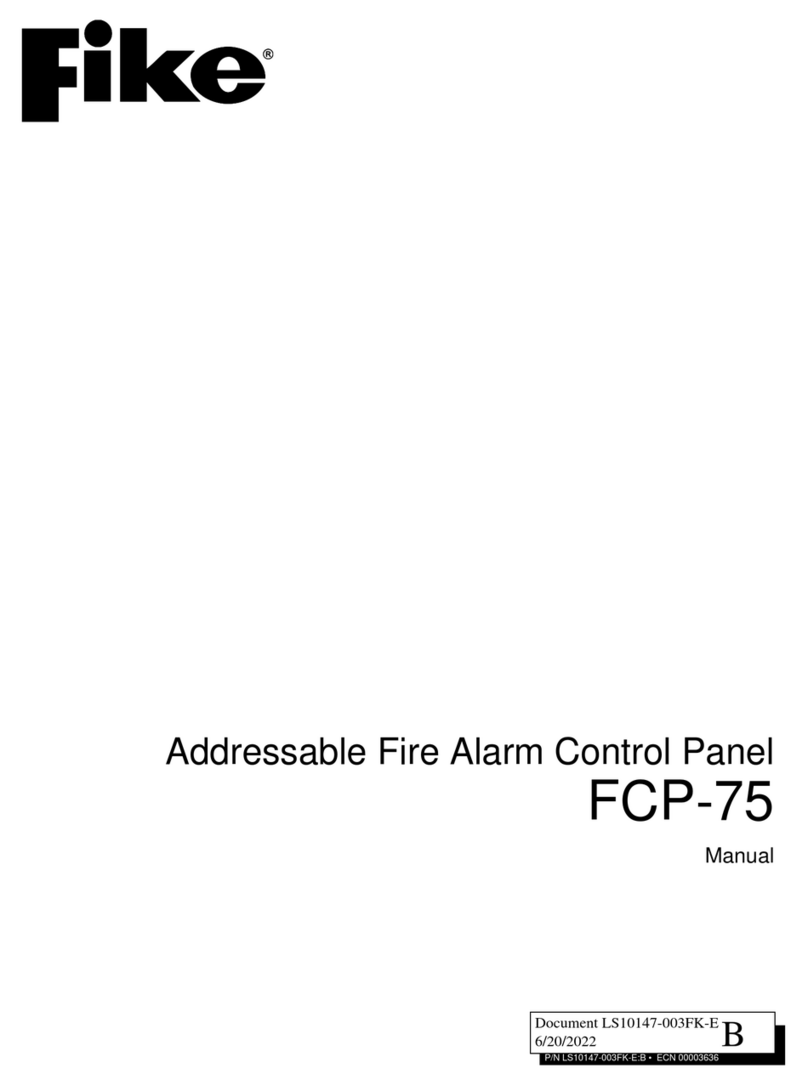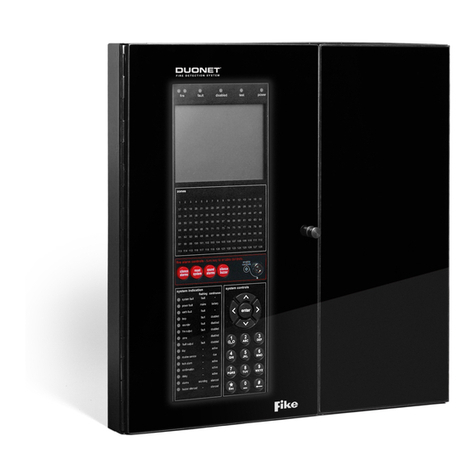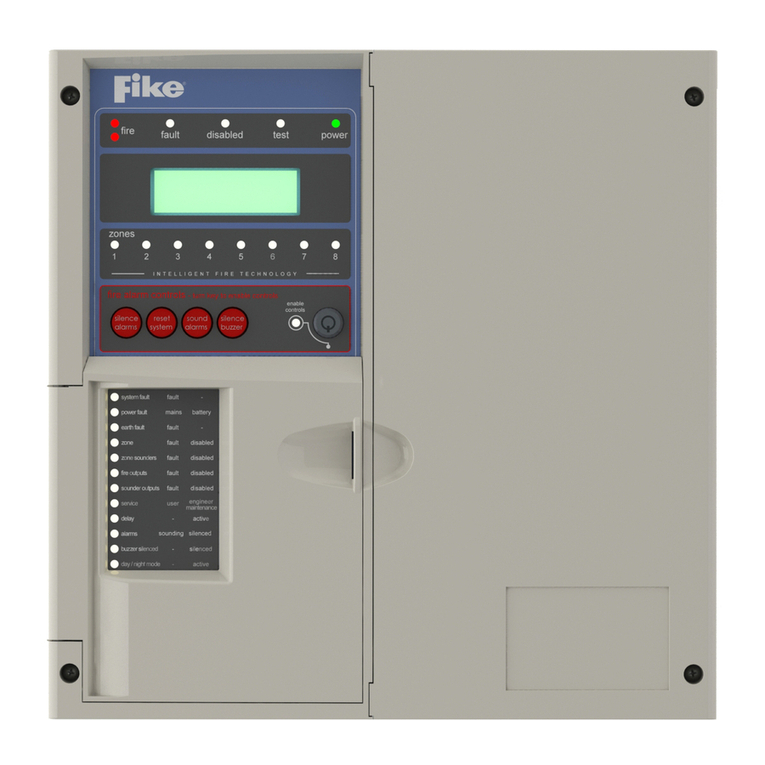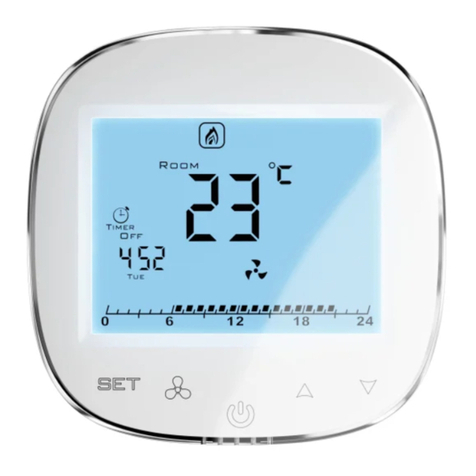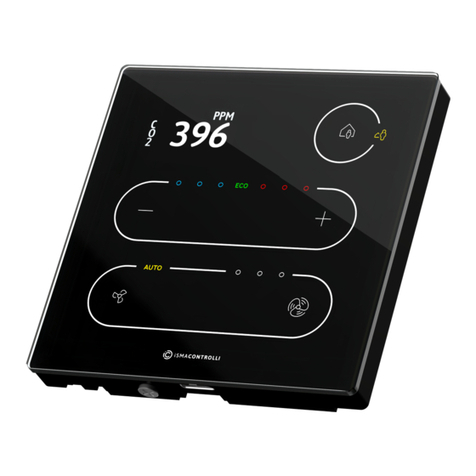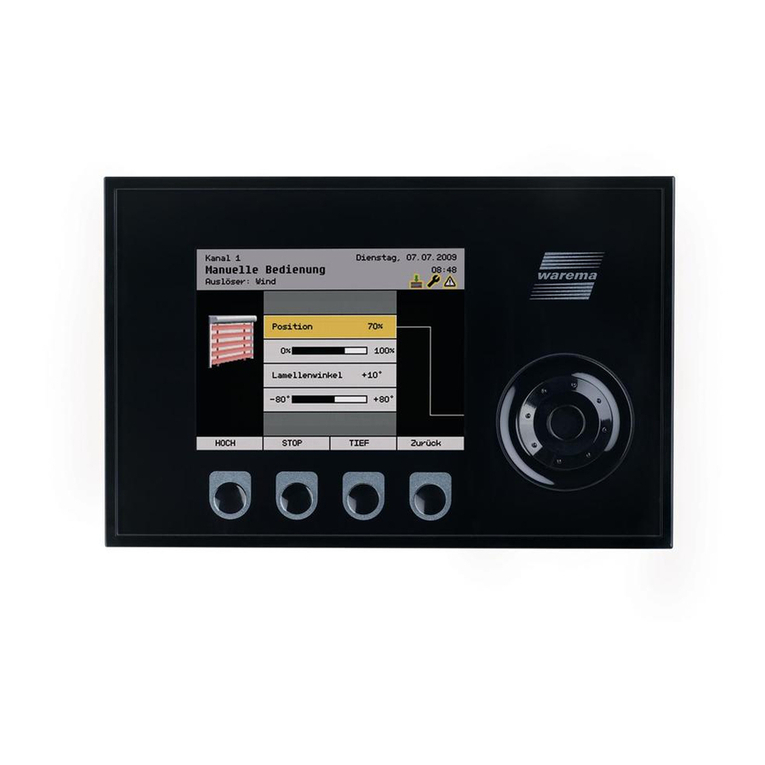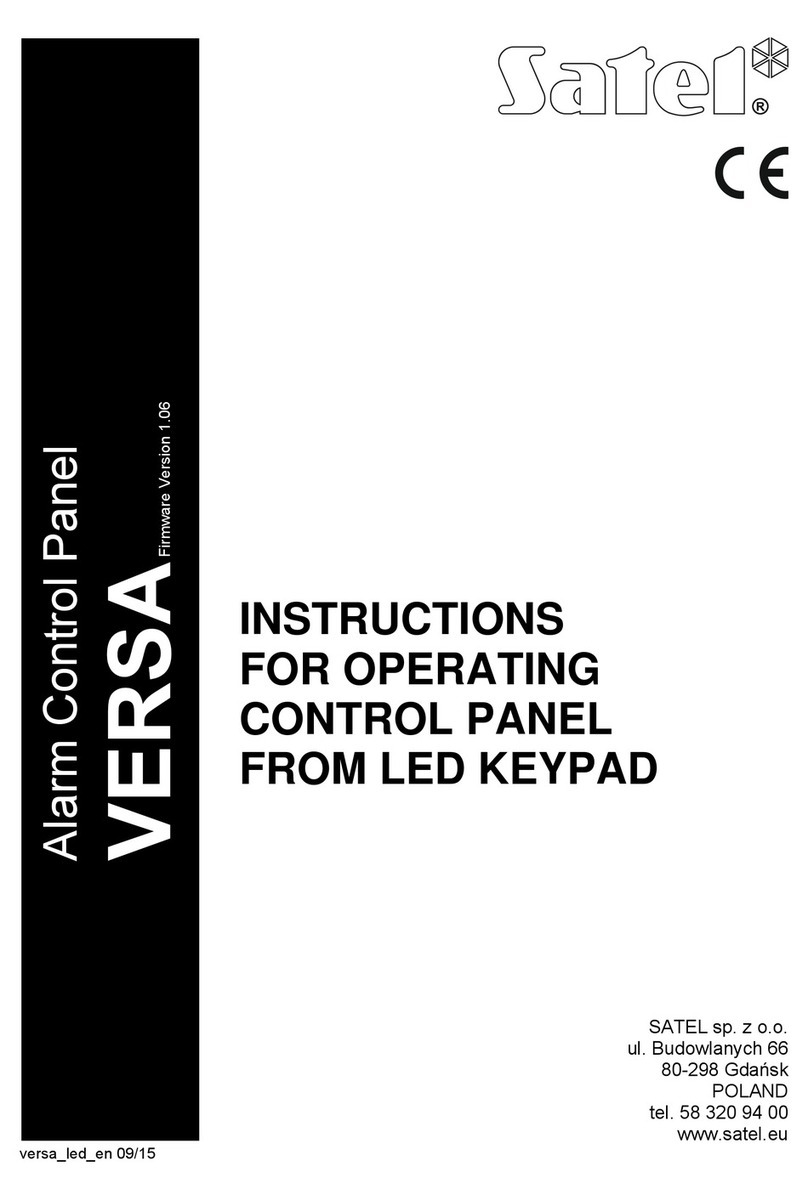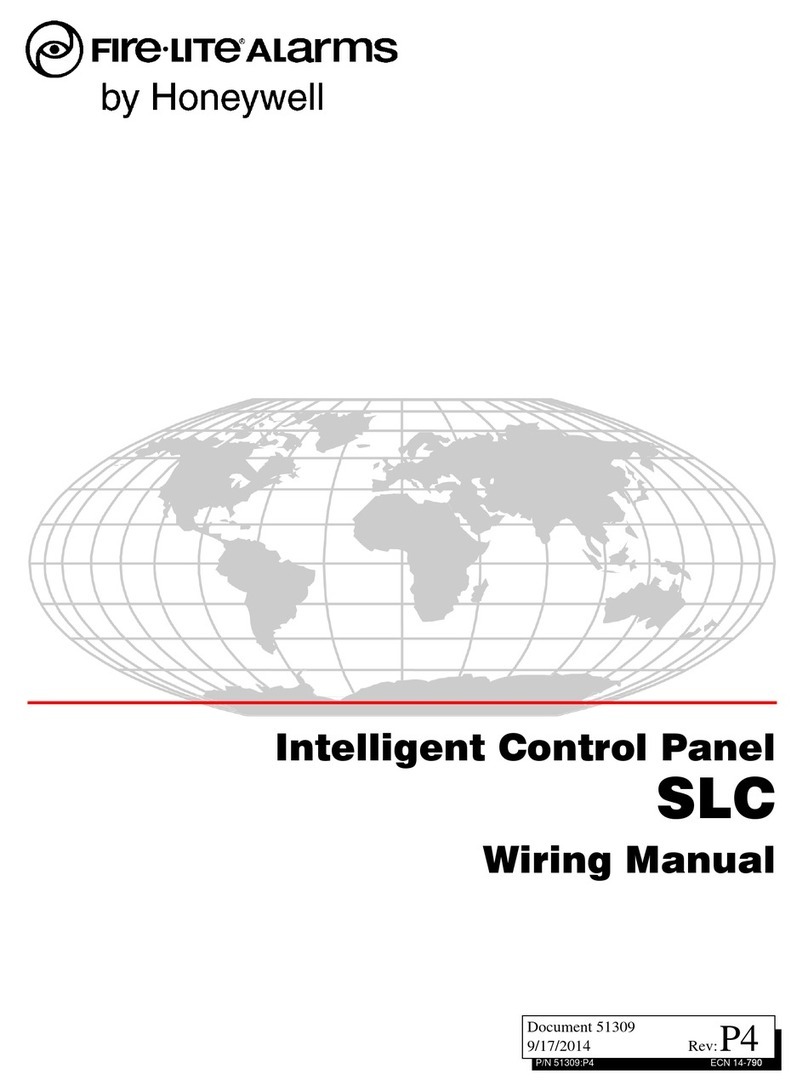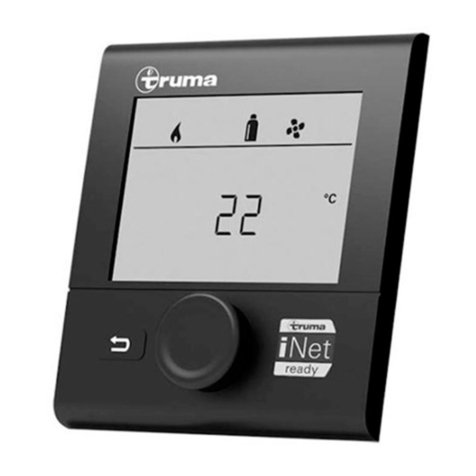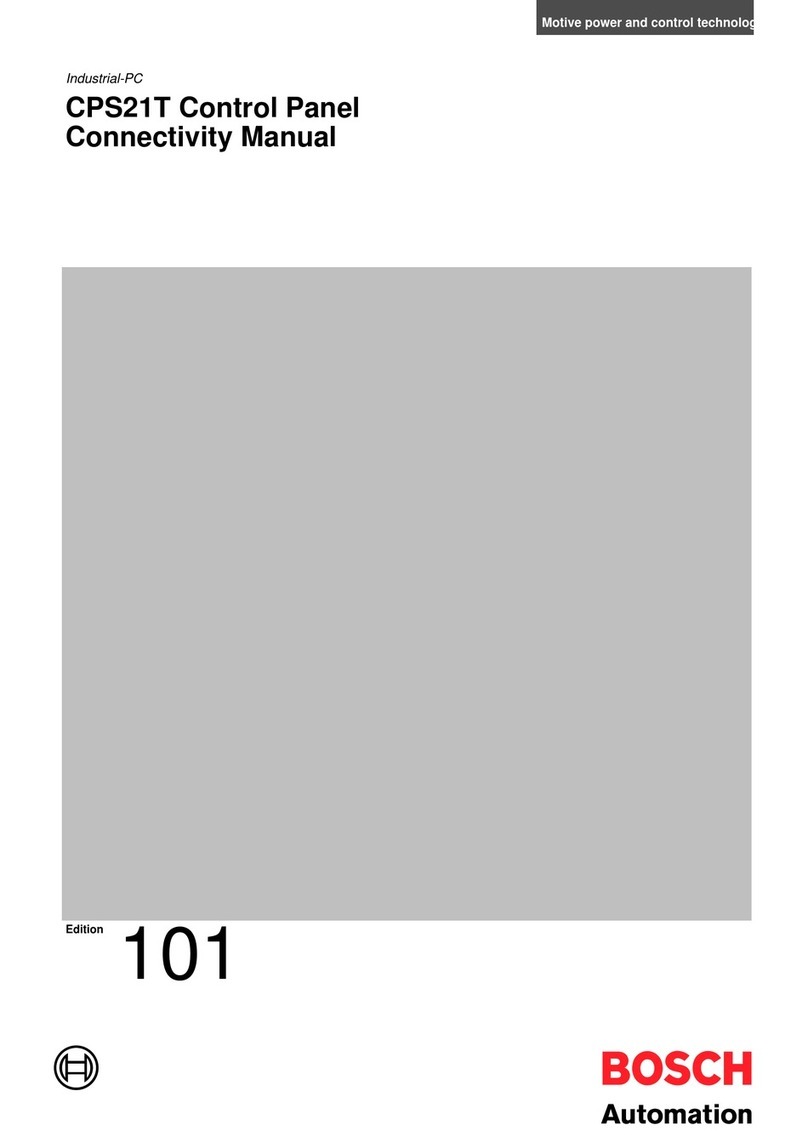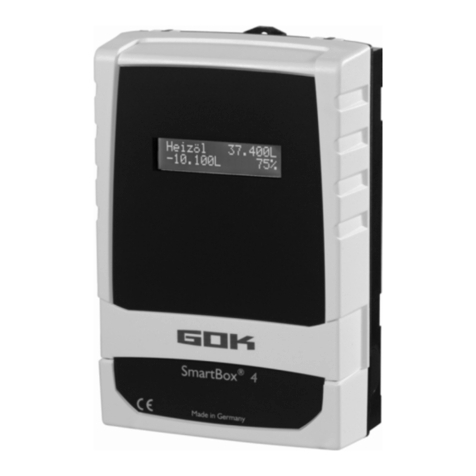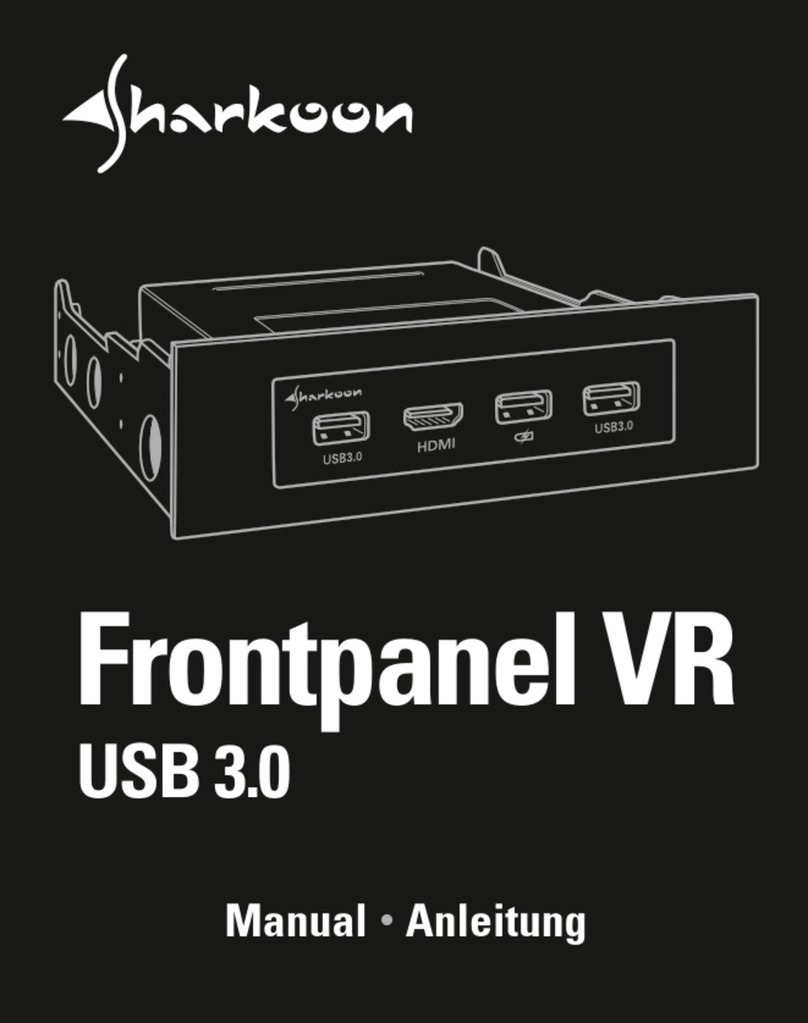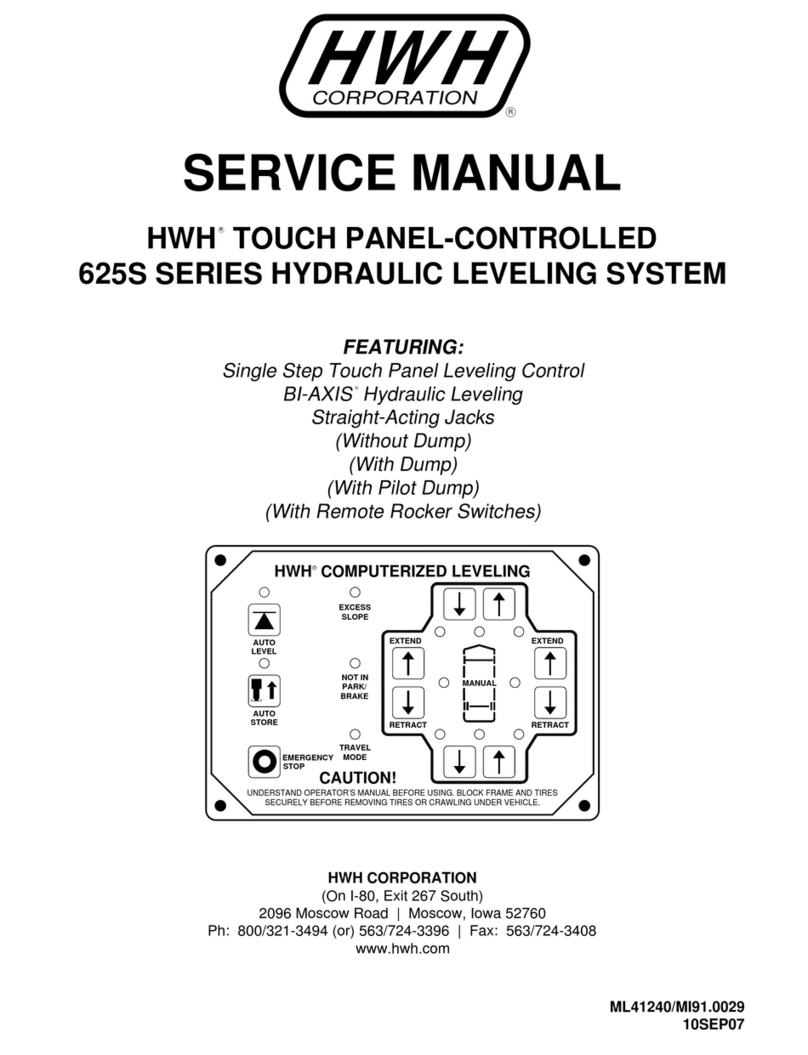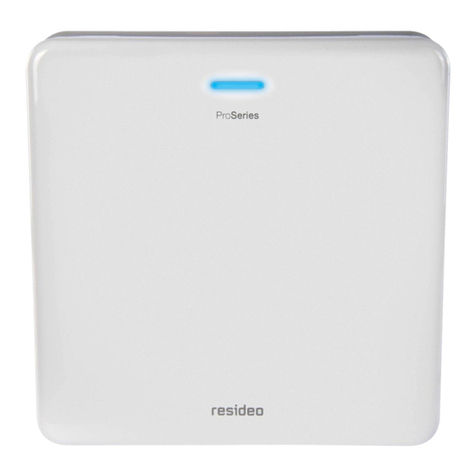Fike FCP-300 User manual

B
P/N LS10145-002FK-E:B • ECN 00003636
Document LS10145-002FK-E
6/20/2022 Rev:
Addressable Fire Alarm Control Panel
FCP-300/FCP-300ECS
Manual

2FCP-300 Series Manual — P/N LS10145-002FK-E:B 6/20/2022
Fire Alarm & Emergency Communication System Limitations
While a life safety system may lower insurance rates, it is not a substitute for life and property insurance!
An automatic fire alarm system—typically made up of smoke
detectors, heat detectors, manual pull stations, audible warning
devices, and a fire alarm control panel (FACP) with remote
notification capability—can provide early warning of a developing fire.
Such a system, however, does not assure protection against property
damage or loss of life resulting from a fire.
An emergency communication system—typically made up of an
automatic fire alarm system (as described above) and a life safety
communication system that may include an autonomous control unit
(ACU), local operating console (LOC), voice communication, and
other various interoperable communication methods—can broadcast
a mass notification message. Such a system, however, does not
assure protection against property damage or loss of life resulting
from a fire or life safety event.
The Manufacturer recommends that smoke and/or heat detectors be
located throughout a protected premises following the
recommendations of the current edition of the National Fire Protection
Association Standard 72 (NFPA 72), manufacturer's
recommendations, State and local codes, and the recommendations
contained in the Guide for Proper Use of System Smoke Detectors,
which is made available at no charge to all installing dealers. This
document can be found at http://www.systemsensor.com/appguides/.
A study by the Federal Emergency ManagementAgency (an agency
of the United States government) indicated thatsmoke detectors may
not go off in as many as 35% of all fires. While fire alarm systems are
designed to provide early warning against fire, they do not guarantee
warning or protection against fire. Afire alarm system may not
provide timely or adequate warning, or simply may not function, for a
variety of reasons:
Smoke detectors may not sense fire where smoke cannot reach the
detectors such as in chimneys, in or behind walls, on roofs, or on the
other side of closed doors.Smoke detectors also may notsense a fire
on another level or floor of a building. A second-floor detector, for
example, may not sense a first-floor or basement fire.
Particles of combustion or “smoke” from a developing fire may not
reach the sensing chambers of smoke detectors because:
• Barriers such as closed or partially closed doors, walls, chimneys,
even wet or humid areas may inhibit particle or smoke flow.
• Smoke particles may become “cold,” stratify, and not reach the
ceiling or upper walls where detectors are located.
• Smoke particles may be blown away from detectors by air outlets,
such as air conditioning vents.
• Smoke particles may be drawn into air returns before reaching the
detector.
The amount of “smoke” present may be insufficient to alarm smoke
detectors. Smoke detectors are designed to alarm at various levels of
smoke density. If such density levels are not created by a developing
fire at the location of detectors, the detectors will not go into alarm.
Smoke detectors, even when working properly, have sensing
limitations. Detectors that have photoelectronic sensing chambers
tend to detect smoldering fires better than flaming fires, which have
little visible smoke. Detectors that have ionizing-type sensing
chambers tend to detect fast-flaming fires better than smoldering
fires. Because fires develop in different ways and are often
unpredictable in their growth, neither type of detector is necessarily
best and a given type of detector may not provide adequate warning
of a fire.
Smoke detectors cannot be expected to provide adequate warning of
fires caused by arson, children playing with matches (especially in
bedrooms), smoking in bed, and violent explosions (caused by
escaping gas, improper storage of flammable materials, etc.).
Heat detectors do not sense particles of combustion and alarm only
when heat on their sensors increases at a predetermined rate or
reaches a predetermined level. Rate-of-rise heat detectors may be
subject to reduced sensitivity over time. For this reason, the rate-of-
rise feature of each detector should be tested at least once per year
by a qualified fire protection specialist. Heat detectors are designed to
protect property, not life.
IMPORTANT! Smoke detectors must be installed in the same room
as the control panel and in rooms used by the system for the
connection of alarm transmission wiring, communications, signaling,
and/or power. If detectors are not so located, a developing fire may
damage the alarm system, compromising its ability to report a fire.
Audible warning devices such as bells, horns, strobes, speakers
and displays may not alert people if these devices are located on the
other side of closed or partly open doors or are located on another
floor of a building. Any warning device may fail to alert people with a
disability or those who have recently consumed drugs, alcohol, or
medication. Please note that:
• An emergency communication system may take priority over a fire
alarm system in the event of a life safety emergency.
• Voice messaging systems must be designed to meet intelligibility
requirements as defined by NFPA, local codes, andAuthorities
Having Jurisdiction (AHJ).
• Language and instructional requirements must be clearly dissemi-
nated on any local displays.
• Strobes can, under certain circumstances, cause seizures in peo-
ple with conditions such as epilepsy.
• Studies have shown that certain people, even when they hear a
fire alarm signal, do not respond to or comprehend the meaning of
the signal.Audible devices, such as horns and bells, can have dif-
ferent tonal patterns and frequencies. It is the property owner's
responsibility to conduct fire drills and other training exercises to
make people aware of fire alarm signals and instruct them on the
proper reaction to alarm signals.
• In rare instances, the sounding of a warning device can cause
temporary or permanent hearing loss.
A life safety system will not operate without any electrical power. If
AC power fails, the system will operate from standby batteries only for
a specified time and only if the batteries have been properly
maintained and replaced regularly.
Equipment used in the system may not be technically compatible
with the control panel. It is essential to use only equipment listed for
service with your control panel.
Alarm Signaling Communications:
•IP connections rely on available bandwidth, which could be lim-
ited if the network is shared by multiple users or if ISP policies
impose restrictions on the amount of data transmitted. Service
packages must be carefully chosen to ensure that alarm signals
will always have available bandwidth. Outages by the ISP for
maintenance and upgrades may also inhibit alarm signals. For
added protection, a backup cellular connection is recommended.
•Cellular connections rely on a strong signal. Signal strength can
be adversely affected by the network coverage of the cellular car-
rier, objects and structural barriers at the installation location. Uti-
lize a cellular carrier that has reliable network coverage where the
alarm system is installed. For added protection, utilize an external
antenna to boost the signal.
•Telephone lines needed to transmit alarm signals from a premise
to a central monitoring station may be out of service or temporarily
disabled. For added protection against telephone line failure,
backup alarm signaling connections are recommended.
The most common cause of life safety system malfunction is
inadequate maintenance. To keep the entire life safety system in
excellent working order, ongoing maintenance is required per the
manufacturer's recommendations, and UL and NFPA standards.At a
minimum, the requirements of NFPA 72 shall be followed.
Environments with large amounts of dust, dirt, or high air velocity
require more frequent maintenance. A maintenance agreement
should be arranged through the local manufacturer's representative.
Maintenance should be scheduled as required by National and/or
local fire codes and should be performed by authorized professional
life safety system installers only. Adequate written records of all
inspections should be kept. Limit-F-2020

FCP-300 Series Manual — P/N LS10145-002FK-E:B 6/20/2022 3
Installation Precautions
Adherence to the following will aid in problem-free installation with long-term reliability:
WARNING - Several different sources of power can be con-
nected to the fire alarm control panel. Disconnect all sources of
power before servicing. Control unit and associated equipment may
be damaged by removing and/or inserting cards, modules, or inter-
connecting cables while the unit is energized. Do not attempt to
install, service, or operate this unit until manuals are read and under-
stood.
CAUTION - System Re-acceptance Test after Software Changes:
To ensure proper system operation, this product must be tested in
accordance with NFPA 72 after any programming operation or
change in site-specific software. Re-acceptance testing is required
after any change, addition or deletion of system components, or after
any modification, repair or adjustment to system hardware or wiring.
All components, circuits, system operations, or software functions
known to be affected by a change must be 100% tested. In addition,
to ensure that other operations are not inadvertently affected, at
least 10% of initiating devices that are not directly affected by the
change, up to a maximum of 50 devices, must also be tested and
proper system operation verified.
This system meets NFPA requirements for operation at 0-49º C/32-
120º F and at a relative humidity 93% ± 2% RH (non-condensing) at
32°C ± 2°C (90°F ± 3°F). However, the useful life of the system's
standby batteries and the electronic components may be adversely
affected by extreme temperature ranges and humidity. Therefore, it
is recommended that this system and its peripherals be installed in
an environment with a normal room temperature of 15-27º C/60-80º
F.
Verify that wire sizes are adequate for all initiating and indicating
device loops. Most devices cannot tolerate more than a 10% I.R.
drop from the specified device voltage.
Like all solid state electronic devices, this system may operate
erratically or can be damaged when subjected to lightning induced
transients.Although no system is completely immune from lightning
transients and interference, proper grounding will reduce susceptibil-
ity. Overhead or outside aerial wiring is not recommended, due to an
increased susceptibility to nearby lightning strikes. Consult with the
Technical Services Department if any problems are anticipated or
encountered.
Disconnect AC power and batteries prior to removing or inserting
circuit boards. Failure to do so can damage circuits.
Remove all electronic assemblies prior to any drilling, filing, ream-
ing, or punching of the enclosure. When possible, make all cable
entries from the sides or rear. Before making modifications, verify
that they will not interfere with battery, transformer, or printed circuit
board location.
Do not tighten screw terminals more than 9 in-lbs. Over-tightening
may damage threads, resulting in reduced terminal contact pressure
and difficulty with screw terminal removal.
This system contains static-sensitive components. Always
ground yourself with a proper wrist strap before handling any circuits
so that static charges are removed from the body. Use static sup-
pressive packaging to protect electronic assemblies removed from
the unit.
Units with a touchscreen display should be cleaned with a dry,
clean, lint free/microfiber cloth. If additional cleaning is required,
apply a small amount of Isopropyl alcohol to the cloth and wipe
clean. Do not use detergents, solvents, or water for cleaning. Do not
spray liquid directly onto the display.
Follow the instructions in the installation, operating, and program-
ming manuals.These instructions must be followed to avoid damage
to the control panel and associated equipment. FACP operation and
reliability depend upon proper installation.
Precau-D2-11-2017
FCC Warning
WARNING: This equipment generates, uses, and can radi-
ate radio frequency energy and if not installed and used in
accordance with the instruction manual may cause interfer-
ence to radio communications. It has been tested and found
to comply with the limits for classA computing devices pur-
suant to Subpart B of Part 15 of FCC Rules, which is
designed to provide reasonable protection against such
interference when devices are operated in a commercial
environment. Operation of this equipment in a residential
area is likely to cause interference, in which case the user
will be required to correct the interference at his or her own
expense.
Canadian Requirements
This digital apparatus does not exceed the ClassA limits for
radiation noise emissions from digital apparatus set out in
the Radio Interference Regulations of the Canadian Depart-
ment of Communications.
Le present appareil numerique n'emet pas de bruits radio-
electriques depassant les limites applicables aux appareils
numeriques de la classeAprescrites dans le Reglement sur
le brouillage radioelectrique edicte par le ministere des
Communications du Canada.
Flexput®, Honeywell®, JumpStart®, and SWIFT® are registered trademarks of Honeywell International Inc.Microsoft® and Windows® are registered trademarks of the
Microsoft Corporation. Chrome™ and Google™ are trademarks of Google Inc. Firefox® is a registered trademark of The Mozilla Foundation.
©2022. All rights reserved. Unauthorized use of this document is strictly prohibited.

4FCP-300 Series Manual — P/N LS10145-002FK-E:B 6/20/2022
Software Downloads
In order to supply the latest features and functionality in fire alarm and life safety technology to our customers, we make frequent
upgrades to the embedded software in our products. To ensure that you are installing and programming the latest features, we strongly
recommend that you download the most current version of software for each product prior to commissioning any system. Contact
Technical Support with any questions about software and the appropriate version for a specific application.
Documentation Feedback
Your feedback helps us keep our documentation up-to-date and accurate. If you have any comments or suggestions about our online
Help or printed manuals, you can email us.
Please include the following information:
• Product name and version number (if applicable)
• Printed manual or online Help
• Topic Title (for online Help)
• Page number (for printed manual)
• Brief description of content you think should be improved or corrected
• Your suggestion for how to correct/improve documentation
Send email messages to:
or call (800)979-3453, x21 in US or (816)229-3405 international
This symbol (shown left) on the product(s) and / or accompanying documents means that used electrical and electronic products
should not be mixed with general household waste. For proper treatment, recovery and recycling, contact your local authorities or
dealer and ask for the correct method of disposal.
Electrical and electronic equipment contains materials, parts and substances, which can be dangerous to the environment and harmful
to human health if the waste of electrical and electronic equipment (WEEE) is not disposed of correctly.

FCP-300 Series Manual — P/N LS10145-002FK-E:B 6/20/2022 5
Table of Contents
Section 1: Introduction ................................................................................................................................................... 10
1.1: Basic System Overview...................................................................................................................................................................................10
1.1.1: Hardware Features................................................................................................................................................................................10
1.1.2: Network System Hardware Features ....................................................................................................................................................10
1.1.3: Software Features .................................................................................................................................................................................10
1.1.4: FCP-300ECS Features..........................................................................................................................................................................10
1.1.5: Terms Used in this Manual...................................................................................................................................................................11
1.2: Compatible Products........................................................................................................................................................................................11
1.3: Related Documentation ...................................................................................................................................................................................12
Section 2: Agency Listings, Approvals, and Requirements........................................................................................ 14
2.1: Federal Communications Commission (FCC).................................................................................................................................................14
2.2: Underwriters Laboratories (UL)......................................................................................................................................................................14
2.2.1: Requirements for All Installations........................................................................................................................................................14
2.2.2: UL 864 9th and 10th Edition ................................................................................................................................................................15
2.2.3: Requirements for Central Station Fire Alarm Systems ........................................................................................................................15
2.2.4: Requirements for Local Protected Fire Alarm Systems .......................................................................................................................15
2.2.5: Requirements for Remote Station Protected Fire Alarm Systems........................................................................................................15
2.2.6: Requirements for the Installation of Carbon Monoxide (CO) Detection and Warning Equipment, NFPA 720..................................15
2.2.7: NFPA Requirements.............................................................................................................................................................................15
Section 3: Prerequisites for Installation........................................................................................................................ 17
3.1: Inventory..........................................................................................................................................................................................................17
3.2: Environmental Specifications..........................................................................................................................................................................17
3.3: Software Downloads........................................................................................................................................................................................17
3.4: Electrical Specifications ..................................................................................................................................................................................17
3.5: Calculating Current Draw and Standby Battery ..............................................................................................................................................18
3.5.1: Worksheet Requirements......................................................................................................................................................................18
3.5.2: Current Draw Worksheet for SLC Devices..........................................................................................................................................19
3.5.3: Maximum Battery Standby Load..........................................................................................................................................................22
Section 4: Control Panel Installation............................................................................................................................. 23
4.1: Mounting the Control Panel Cabinet...............................................................................................................................................................23
4.1.1: Preventing Water Damage....................................................................................................................................................................23
4.1.2: Removing the FCP-300 Assembly from the Housing..........................................................................................................................23
4.1.3: Ethernet Connection .............................................................................................................................................................................23
4.2: Board Layout ...................................................................................................................................................................................................24
4.3: Wiring Specifications.......................................................................................................................................................................................24
4.4: AC Connection.................................................................................................................................................................................................26
4.5: Battery Power ..................................................................................................................................................................................................26
4.5.1: RBB Accessory Cabinet.......................................................................................................................................................................27
4.6: Wiring Specifications.......................................................................................................................................................................................28
4.6.1: Length Limitations................................................................................................................................................................................28
4.6.2: Calculating Wiring Distance for SBUS Modules.................................................................................................................................28
4.6.3: Wiring Configurations..........................................................................................................................................................................30
4.7: FIK-RA100 Remote Annunciator Installation.................................................................................................................................................30
4.7.1: Mounting the FIK-RA100 ....................................................................................................................................................................32
4.7.2: FIK-RA100 Connection to the Panel....................................................................................................................................................33
4.8: FIK-RA1000R Remote Annunciator Installation............................................................................................................................................33
4.8.1: Mounting the FIK-RA1000R................................................................................................................................................................34
4.9: FIK-RA2000 Remote Annunciator Installation...............................................................................................................................................36
4.9.1: Mounting the FIK-RA2000 ..................................................................................................................................................................36
4.9.2: FIK-RA2000 Connection to the Panel..................................................................................................................................................38
4.10: FIK-6815 Installation.....................................................................................................................................................................................38
4.10.1: FIK-6815 Connection to the Panel .....................................................................................................................................................39
4.11: FIK-5824 Serial/Parallel Printer Interface Module Installation.....................................................................................................................39
4.11.1: Selecting FIK-5824 Options...............................................................................................................................................................39
4.12: FIK-5880 LED I/O Module...........................................................................................................................................................................40
4.12.1: FIK-5880 Board Layout .....................................................................................................................................................................41
4.12.2: FIK-5880 Connection to Panel...........................................................................................................................................................41
4.12.3: LED Wiring ........................................................................................................................................................................................41
4.12.4: Dry Contact Wiring ............................................................................................................................................................................42

6FCP-300 Series Manual — P/N LS10145-002FK-E:B 6/20/2022
Table of Contents
4.13: FIK-5865-3 / FIK-5865-4 LED Annunciator Installation .............................................................................................................................43
4.13.1: FIK-5865 Connection to Panel...........................................................................................................................................................43
4.13.2: FIK-5865 Mounting............................................................................................................................................................................44
4.14: Configuring SBUS Modules..........................................................................................................................................................................44
4.14.1: Assigning SBUS Module IDs.............................................................................................................................................................44
4.14.2: SBUS Bandwidth Considerations.......................................................................................................................................................45
4.15: Telephone Connection ...................................................................................................................................................................................45
4.16: Notification Appliance/Auxiliary Power Circuits .........................................................................................................................................46
4.16.1: Conventional Notification Appliance.................................................................................................................................................46
4.16.2: Auxiliary Power Installation...............................................................................................................................................................47
4.17: Onboard Relays (Conventional) ....................................................................................................................................................................48
4.17.1: Trouble Relay .....................................................................................................................................................................................48
4.17.2: Programmable Relays.........................................................................................................................................................................48
4.18: Remote Station Applications .........................................................................................................................................................................48
4.18.1: Keltron Model 3158 Installation.........................................................................................................................................................48
4.18.2: City Box Connection Using the 5220 Module ...................................................................................................................................49
4.18.3: Using the Addressable Relay Module for City Box Connection........................................................................................................50
4.18.4: NFPA 72 Polarity Reversal ................................................................................................................................................................51
4.18.5: Transmitter Activated by Dry Contacts..............................................................................................................................................53
Section 5: Networking..................................................................................................................................................... 54
5.1: Network System Hardware Features ...............................................................................................................................................................54
5.1.1: Networked Sites....................................................................................................................................................................................54
5.2: Network Wiring ...............................................................................................................................................................................................54
5.2.1: Wiring Options/Requirements to Connect Networked Panels .............................................................................................................54
5.3: FIK-NIC Wiring Options.................................................................................................................................................................................55
5.3.1: Fiber Loop Modules .............................................................................................................................................................................55
5.3.2: FIK-NIC Mounting Kits .......................................................................................................................................................................56
5.4: SK-NIC Installation.........................................................................................................................................................................................56
5.4.1: FIK-NIC Remote Mounting .................................................................................................................................................................57
5.4.2: Wiring...................................................................................................................................................................................................57
5.5: Setting the Network ID for Each Panel ...........................................................................................................................................................59
Section 6: Network Management................................................................................................................................... 60
6.1: Network Diagnostics .......................................................................................................................................................................................60
6.1.1: Ping Panel.............................................................................................................................................................................................60
6.1.2: Data Network Status.............................................................................................................................................................................60
6.1.3: Voice Network Status...........................................................................................................................................................................60
6.2: Network Programming ....................................................................................................................................................................................60
6.2.1: Learn Network......................................................................................................................................................................................60
6.2.2: Edit Network Names.............................................................................................................................................................................60
6.2.3: Edit Panel ID.........................................................................................................................................................................................61
6.2.4: Computer Access..................................................................................................................................................................................61
6.2.5: Access Codes........................................................................................................................................................................................61
6.2.6: Communicator Options.........................................................................................................................................................................61
6.3: Voice Options...................................................................................................................................................................................................62
6.3.1: Edit Timers ...........................................................................................................................................................................................62
6.3.2: Edit Voice Commands..........................................................................................................................................................................63
6.4: Sync Network Options.....................................................................................................................................................................................64
6.5: Network Management Quick Reference .........................................................................................................................................................64
Section 7: Programming Overview................................................................................................................................ 66
7.1: JumpStart Auto-programming .........................................................................................................................................................................66
7.1.1: Input Points...........................................................................................................................................................................................66
7.1.2: Output Points ........................................................................................................................................................................................66
7.1.3: Running JumpStart Auto-programming...............................................................................................................................................66
7.2: Mapping Overview ..........................................................................................................................................................................................67
7.2.1: Input Point Mapping.............................................................................................................................................................................68
7.2.2: Output Circuit Mapping........................................................................................................................................................................68
7.2.3: Event Mapping.....................................................................................................................................................................................69
7.2.4: Mapping LED Points............................................................................................................................................................................71
7.2.5: Mapping LED Points for a Networked System....................................................................................................................................71
7.3: Programming Using the HFSS Software Suite................................................................................................................................................71

FCP-300 Series Manual — P/N LS10145-002FK-E:B 6/20/2022 7
Table of Contents
7.4: Programming Using an Annunciator ...............................................................................................................................................................72
7.4.1: Entering / Exiting Panel Programming.................................................................................................................................................72
7.4.2: Moving through the Menus ..................................................................................................................................................................72
7.4.3: Selecting Options and Entering Data....................................................................................................................................................72
7.5: Programming Menu Quick Reference.............................................................................................................................................................73
Section 8: Programming................................................................................................................................................. 83
8.1: UL 864 / UL 2572 Programming Requirements..............................................................................................................................................83
8.2: Modules ...........................................................................................................................................................................................................83
8.2.1: Edit Modules.........................................................................................................................................................................................83
8.2.2: Adding a Module..................................................................................................................................................................................84
8.2.3: Deleting a Module ................................................................................................................................................................................84
8.2.4: View Module List.................................................................................................................................................................................85
8.3: Zone.................................................................................................................................................................................................................85
8.3.1: Edit Zone ..............................................................................................................................................................................................85
8.3.2: View Zone Points .................................................................................................................................................................................87
8.4: Group...............................................................................................................................................................................................................87
8.4.1: Edit Group ............................................................................................................................................................................................87
8.4.2: View Group Points ...............................................................................................................................................................................89
8.4.3: Edit OPG (Output Group) Template.....................................................................................................................................................89
8.5: Point.................................................................................................................................................................................................................89
8.5.1: Point Programming for an FIK-6815 Module ......................................................................................................................................91
8.5.2: Point Programming For Internal or External Power Module (FIK-RPS1000).....................................................................................93
8.5.3: Point Programming for FIK-5880 or FIK-5865 Modules ....................................................................................................................95
8.5.4: Point Programming for the FIK-5496...................................................................................................................................................95
8.5.5: Point Programming for ECS Amplifiers...............................................................................................................................................96
8.5.6: Point Programming for FIK-NVCM and FIK-RVM Modules.............................................................................................................96
8.6: System Options................................................................................................................................................................................................96
8.6.1: Communication Options.......................................................................................................................................................................96
8.6.2: Daytime/Nighttime Sensitivity.............................................................................................................................................................99
8.6.3: Holiday Days ........................................................................................................................................................................................99
8.6.4: Time Options ........................................................................................................................................................................................99
8.6.5: Miscellaneous Options........................................................................................................................................................................100
8.6.6: Daylight Savings Options...................................................................................................................................................................101
8.6.7: Edit Banner.........................................................................................................................................................................................101
8.6.8: SLC Family.........................................................................................................................................................................................101
8.7: JumpStart Auto-Programming.......................................................................................................................................................................102
8.8: Restore Defaults.............................................................................................................................................................................................102
8.9: Voice Options.................................................................................................................................................................................................102
8.9.1: VCM Maintenance..............................................................................................................................................................................102
8.9.2: Voice Settings.....................................................................................................................................................................................102
Section 9: System Operation........................................................................................................................................ 103
9.1: Annunciator Description................................................................................................................................................................................103
9.1.1: LCD Display.......................................................................................................................................................................................103
9.1.2: Banner.................................................................................................................................................................................................103
9.2: Menu System .................................................................................................................................................................................................104
9.2.1: Panel Login Menu...............................................................................................................................................................................104
9.2.2: Main Menu Overview.........................................................................................................................................................................105
9.2.3: Using the Menus.................................................................................................................................................................................105
9.3: Basic Operation .............................................................................................................................................................................................106
9.3.1: Setting Time and Date ........................................................................................................................................................................106
9.3.2: Disable / Enable a Point......................................................................................................................................................................106
9.3.3: View Event History ............................................................................................................................................................................106
9.3.4: Conduct a Fire Drill............................................................................................................................................................................106
9.3.5: Conduct an Indicator Test...................................................................................................................................................................107
9.3.6: Conduct a Walk Test ..........................................................................................................................................................................107
9.3.7: Conduct a Communicator Test...........................................................................................................................................................107
9.3.8: Manual AlarmNet Registration...........................................................................................................................................................107
9.3.9: Silence Alarms or Troubles................................................................................................................................................................107
9.3.10: Reset Alarms.....................................................................................................................................................................................108
9.3.11: Check Detector Sensitivity Through Point Status ............................................................................................................................108
9.3.12: View Status of a Point ......................................................................................................................................................................109

8FCP-300 Series Manual — P/N LS10145-002FK-E:B 6/20/2022
Table of Contents
9.3.13: View Alarms or Troubles .................................................................................................................................................................109
9.3.14: System Information ..........................................................................................................................................................................109
9.4: Event Priority.................................................................................................................................................................................................110
9.4.1: System Control ...................................................................................................................................................................................110
9.4.2: System Override .................................................................................................................................................................................110
9.4.3: Event Priority......................................................................................................................................................................................110
9.4.4: Priority Rules......................................................................................................................................................................................111
9.4.5: Other Priority Considerations.............................................................................................................................................................111
9.5: Panel Operating Modes..................................................................................................................................................................................111
9.5.1: Multi-Site Annunciator and Multi-Site User Access..........................................................................................................................114
9.6: Releasing Operations.....................................................................................................................................................................................114
9.6.1: Single Interlock Zone Releasing.........................................................................................................................................................115
9.6.2: Double Interlock Zone Releasing.......................................................................................................................................................115
9.7: Smoke Alarm Verification .............................................................................................................................................................................116
9.8: Function Keys...............................................................................................................................................................................................116
9.8.1: Recording an F-Key Macro ................................................................................................................................................................116
9.8.2: Aborting an F-Key Macro Recording Session....................................................................................................................................116
9.8.3: Erasing an F-Key Macro.....................................................................................................................................................................117
9.8.4: Using a Recorded F-Key Macro.........................................................................................................................................................117
9.8.5: F-Key Status Event.............................................................................................................................................................................117
9.8.6: F-Key Map Inhibit..............................................................................................................................................................................117
Section 10: Emergency Communication System Operation..................................................................................... 118
10.1: Overview......................................................................................................................................................................................................118
10.2: LOC Functionality.......................................................................................................................................................................................118
10.2.1: Keys and LEDs.................................................................................................................................................................................118
10.2.2: Gaining ECS Control........................................................................................................................................................................119
10.2.3: Manual ECS......................................................................................................................................................................................119
10.2.4: Fire Page Mode.................................................................................................................................................................................120
10.2.5: Message Mode..................................................................................................................................................................................120
10.2.6: Custom ECS Event ...........................................................................................................................................................................121
10.2.7: Passing ECS Control.........................................................................................................................................................................121
10.2.8: Exit ECS Control Menu....................................................................................................................................................................121
10.2.9: Relinquish ECS Control ...................................................................................................................................................................121
10.2.10: ECS Reset .......................................................................................................................................................................................122
10.3: ECS Super User ...........................................................................................................................................................................................122
10.4: ECS Point Functionality ..............................................................................................................................................................................122
10.4.1: ECS Point Activations......................................................................................................................................................................122
10.4.2: FIK-NVCM and FIK-RVM Points...................................................................................................................................................122
10.5: Amplifier Programming...............................................................................................................................................................................122
10.5.1: Adding an Amplifier.........................................................................................................................................................................122
10.5.2: Editing an Amplifier.........................................................................................................................................................................123
10.6: LOC Programming ......................................................................................................................................................................................123
10.6.1: Adding an LOC.................................................................................................................................................................................123
10.6.2: Editing an LOC.................................................................................................................................................................................123
10.7: Using the Microphone .................................................................................................................................................................................124
10.7.1: Microphone Functionality ................................................................................................................................................................124
10.7.2: Custom ECS Event ...........................................................................................................................................................................124
10.7.3: Fire Page...........................................................................................................................................................................................124
10.7.4: Emergency Page ...............................................................................................................................................................................124
10.7.5: Paging ...............................................................................................................................................................................................124
10.8: Recording Custom Messages.......................................................................................................................................................................125
10.8.1: Recording Messages 1-15 Using Aux Audio Input..........................................................................................................................125
10.8.2: Recording Messages 1-15 Using the Microphone............................................................................................................................126
10.8.3: Erasing User Messages.....................................................................................................................................................................127
10.8.4: Using HFSS Voice Message Load Software....................................................................................................................................127
10.9: Network Paging ...........................................................................................................................................................................................128
10.9.1: Priority..............................................................................................................................................................................................128
10.9.2: Configuration....................................................................................................................................................................................128
Section 11: Reporting ................................................................................................................................................... 129
11.1: Receivers Compatible with the Control Panel.............................................................................................................................................129
11.2: SIA - Panels PI Modifier Reporting.............................................................................................................................................................138

FCP-300 Series Manual — P/N LS10145-002FK-E:B 6/20/2022 9
Table of Contents
11.3: SIA – Panel Communicator .........................................................................................................................................................................138
Section 12: Testing and Troubleshooting................................................................................................................... 140
12.1: Troubleshooting...........................................................................................................................................................................................140
12.1.1: Common Problems ...........................................................................................................................................................................140
12.2: Periodic Testing and Maintenance...............................................................................................................................................................140
12.3: Event History...............................................................................................................................................................................................141
12.4: Built-in Troubleshooting and Testing Tools ................................................................................................................................................141
12.4.1: SLC Device Locater .........................................................................................................................................................................141
12.4.2: SLC Multiple Device Locater...........................................................................................................................................................141
12.4.3: I/O Point Control ..............................................................................................................................................................................142
12.4.4: Earth Fault Resistance ......................................................................................................................................................................142
Section 13: Installation Records.................................................................................................................................. 143
13.1: Detector and Module Point Record .............................................................................................................................................................143
13.2: Additional SLC Devices ..............................................................................................................................................................................145
13.3: Conventional Output Point Record..............................................................................................................................................................146
Appendix A: Editing Text Using the Built-In Programmer......................................................................................... 147
A.1: Characters Used for Editing Text..................................................................................................................................................................147
A.2: Example Name Edit......................................................................................................................................................................................147
Appendix B: Expanded Receiver/Panel Relationship................................................................................................ 148
Appendix C: Cadence Patterns.................................................................................................................................... 149
Appendix D: Panel Security.......................................................................................................................................... 150
Model FCP-300 Basic Operating Instructions............................................................................................................. 151
Model FCP-300ECS Basic Operating Instructions..................................................................................................... 153
Keypad and LED Indicators.......................................................................................................................................... 155
ECS Control ................................................................................................................................................................... 157

10 FCP-300 Series Manual — P/N LS10145-002FK-E:B 6/20/2022
Section 1: Introduction
The FCP-300 and FCP-300ECS are analog addressable fire alarm control panels (FACP), that meet the requirements of UL 864.
The FCP-300ECS is an intelligent fire alarm control panel combined with an Emergency Communication System that meets the require-
ments for Mass Notification as described in UL 864 and UL 2572.
1.1 Basic System Overview
The FCP-300 is an addressable panel with a built-in annunciator that can also be used to program the system.
1.1.1 Hardware Features
• The basic FCP-300 panel contains one built in signaling line circuit (SLC), which supports up to 159 sensors and 159 modules.
Additional SLC loops can be added to increase overall point capacity.
• Additional FIK-6815 SLC expanders supports 159 sensors and 159 modules for a maximum of 300 points per control panel.
• 6.0A of output power is available through 4 sets of terminals for notification appliance circuits or auxiliary applications. Each circuit is
power-limited per UL864 and can source up to 3.0A (total output power for all 4 circuits must not exceed 6.0A). The constant auxiliary
power load must not exceed 3A for normal standby.
• Built-in dual phone line, digital alarm communicator/transmitter (DACT), IP or optional cellular technologies.
• Reports events to central station by point or by zone.
• UL Listed for pre-action and deluge releasing systems.
• Two general purpose Form C programmable relays.
• One Form C Trouble Relay.
• Can be used with up to 16 model FIK-RA100, FIK-RA1000, or FIK-RA20000 remote annunciators in any combination (sold
separately).
• Can be used with model FIK-5865-3, FIK-5865-4, and FIK-5880 in any combination for a total of eight devices on one control panel.
See Section 4.12 and Section 4.13 for additional information on these models.
• Printing of event log available through the Model FIK-5824 serial/parallel printer interface module.
• 250 software zones, 250 output groups.
• Add six Flexput circuits with each FIK-RPS1000 power supply.
• Add four NAC circuits with each FIK-5496 NAC expander.
1.1.2 Network System Hardware Features
• The default network setup can contain up to 32- FCP-300 panels connected.
• Network support for up to 32 sites
• Each building is referred to as a “site”.
• Panels can be interconnected using a CLASS B or CLASS A topology.
• To network panels together use the FIK-NIC network card. Copper wire or fiber-optic cable panel connectivity can be used within the
same networked system.
• The network architecture provides true peer to peer capability allowing network survivability for all hardware that remains operational
in the event of partial system failure.
1.1.3 Software Features
• Advanced smoke detector features:
– Automatic drift compensation
– Automatic day/night sensitivity adjustment
– Maintenance alert region
– Point status meets calibrated smoke test requirements for NFPA 72
• “JumpStart” feature for easy programming
• Non-volatile event history stores 1000 events
• A choice of output patterns available for notification outputs, including ANSI 3.41 temporal signal
• Built-in synchronization appliance support for AMSECO®, Gentex®, System Sensor®, and Wheelock®
1.1.4 FCP-300ECS Features
• Can select ECS message as priority over fire alarm
• 15 recordable messages that can be mapped to eight ECS buttons
• Supports up to seven FIK-LOC consoles
• Support for one FIK-NVCM
• Programmable trigger inputs from an external source, such as a Monaco system, to either the FIK-NVCM, FIK-RVM, FIK-5880 or any
SLC input module
• Fire alarm and ECS combined in one easy to program system
NOTE: All references to FCP-300 within this manual are applicable to the FCP-300 and FCP-300ECS unless specified.
NOTE: The system can include a maximum of 16 intelligent power modules, FIK-5496 or FIK-RPS1000, combined.

FCP-300 Series Manual — P/N LS10145-002FK-E:B 6/20/2022 11
Compatible Products Introduction
• Supports up to eight FIK-50W, FIK-125W, FIK-INT50W, or FIK-DUAL50W addressable amplifiers for a maximum of 1000 watts per
system
• Support for dual channel and backup audio using the FIK-DUAL50W amplifier and FIK-50WBU back-up amplifier
1.1.5 Terms Used in this Manual
The following terminology is used with the FCP-300 system:
1.2 Compatible Products
The chart below lists the products available from Honeywell for use with the FCP-300.
Term Description
SLC Signaling Line Circuit
Module The term module is used for all hardware devices except for SLC addressable devices and notification
appliances. This includes the FCP-300 panel itself.
Input Point An addressable sensing device, such as a smoke or heat detector or a contact monitor device.
Input Zone A protected area made up of input points.
Output Point
(or Output Circuit) A notification point or circuit for notification appliances. Relay circuits and auxiliary power circuits are also
considered output points.
Output Group (OPG) A group of output points. Operating characteristics are common to all output points in the group.
Output (or “Cadence”) Pattern The pattern that the output will use, for example, Constant, March Code, ANSI 3.41. Applies to zones and
special system events. See Appendix C for additional information.
Mapping Mapping is the process of specifying which outputs are activated when certain events occur in the system.
Section 7.2 explains mapping in detail.
ECS Emergency Communication System
Networking Up to 32 panels can be networked.
Network System Consist of any combination of 32 panels of these model numbers: FCP-75, FCP-300, FCP-300ECS,
FCP-2100, and FCP-2100ECS.
SWIFT Smart Wireless Integrated Fire Technology
Type of Device Model Description
SWIFT Wireless SLC Devices For a list of compatible devices, refer to the Device Compatibility Document and SLC Wiring Manual.
Addressable SLC Devices
Other Modules
FIK-5824 Serial/Parallel
Printer Interface Module Allows a printer to be attached for the system for on-site event logging. Four maximum
per system.
FIK-6815 SLC Expander Supports System Sensor Devices only. Each FIK-6815 supports up to 159 sensors and
159 modules. Maximum point count is 300 per panel.
FIK-RPS1000 Intelligent
Power Supply Provides additional power, six Flexput circuits,
and two Form C relays. FIK-RPS1000 and FIK-5496 modules
can be used in any combination, up to
a total of 16 on one system.
FIK-5496 (Rev F or
above) NAC Expander Add 4 Notification/Auxiliary power circuits with
each FIK-5496 Intelligent Power Module
FIK-RA2000Remote LCD
Annunciator 4x 40 Remote LCD annunciator, can be used in any combination, up to a total of 16
devices on one panel.
FIK-RA100 Remote LCD
Annunciator 4 x 20 Remote LCD annunciator, can be used in any combination, up to a total of 16
devices on one panel.
FIK-RA1000R Remote
LCD Annunciator 4 x 20 Remote LCD annunciator, can be used in any combination, up to a total of 16
devices on one panel.
5860TR Trim Ring Kit Red trim ring kit for surface mounting the FIK-RA1000R annunciator.
FIK-5865-3 and FIK-
5865-4 LED Annunciator LED annunciator can display up to 30 LEDs (15
red and 15 yellow). FIK-5865-4 has key
switches for silence and reset, and a system
trouble LED.
FIK-5865-3, FIK-5865-4, and FIK-
5880 can be used in any combination,
up to a total of eight devices on one
panel.
FIK-5880 (Rev C or
above) LED I/O Module Driver for up to 40 LEDs. Interfaces with
customized annunciator boards. In addition the
FIK-5880 has eight generic switch input points.
FIK-5883 General
Purpose Relay Module Provides 10 Form C relays. Designed to be driven by the FIK-5880. Up to four, FIK-5883
modules can be used with each FIK-5880 module.
FIK-NIC Network Interface Card Refer to LS10172-002FK-E
Table 1.1 FCP-300 Compatible Products

12 FCP-300 Series Manual — P/N LS10145-002FK-E:B 6/20/2022
Introduction Related Documentation
1.3 Related Documentation
Refer to the following documents for more information.
ECS Modules
FIK-NVCM Network Voice Control Module Refer to the ECS Series Installation
Manual P/N LS10262-001FK-E for
more information on these
accessories.
FIK-SW24 24 switch expander
FIK-50W 50 watt audio amplifier
FIK125W 125 watt audio amplifier
FIK-CE4 Provides 4 additional audio circuits for the FIK-
50W or FIK-125W.
FIK-RVM Remote Voice Module
FIK-DUAL50W Dual Channel amplifier
FIK-50WBU Backup daughter card
FIK-INT50W 50 wall internal amplifier
FIK-LOC Local Operating Console
Wireless
FIK-W-WGI Wireless Gateway
Refer to the SWIFT Wireless
Installation Manual
P/N LS10036-000FK-E for more
information on these accessories.
FIK-W-PHOTO Wireless Photoelectric Smoke Detector
FIK-W-ACCLIMATE Wireless multi-criteria photoelectric smoke
detector
FIK-W-HEAT-ROR Wireless Rate of Rise Heat Detector
FIK-W-HEAT Wireless 135° Fixed Heat Detector
FIK-W-MONITOR Wireless Addressable Monitor Module
FIK-W-RELAY Wireless Addressable Relay Module
B210W 6" wireless base
Miscellaneous
HFSS Software Suite For communication and panel programming with a Windows-based computer. Enables
remote viewing of detector status and event history.
7860 Telephone Cord RJ31X cord for connecting a phone line to the FCP-300.
RBB Remote Battery Box for mounting backup batteries that are too large to fit into the main
control panel cabinet. Dimensions: 16" W x 10" H x 6" D
(40.64 cm W x 25.4 cm H x 15.24 cm D).
Type of Device Model Description
Table 1.1 FCP-300 Compatible Products (Continued)
Title Document Number
SLC Wiring Manual LS10179-000FK-E
Device Compatibility Document LS10167-005FK-E
FIK-5824 Printer Interface Module Install Sheet LS10254-002FK-E
FIK-RPS1000 Power Supply Manual LS10259-001FK-E
FIK-5496 NAC Expander Manual LS10253-001FK-E
FIK-RA100 Annunciator Install Sheet LS10260-001FK-E
FIK-RA1000R LCD Annunciator Install Sheet LS10258-001FK-E
FIK-RA2000 LCD Annunciator LS10261-001FK-E
FIK-5865-3 and FIK-5865-4 LED Annunciator LS10255-001FK-E
FIK-5880 LED Driver Module LS10256-001FK-E
FIK-5883 General Purpose Relay Module LS10257-001FK-E
Fike ECS Series Manual LS10262-001FK-E
FIK-RVM Install Sheet LS10311-001FK-E
FIK-SW24 Install Sheet LS10264-001FK-E
FIK-CE4 Install Sheet LS10263-001FK-E
FIK-INT50W Install Sheet LS10119-002FK-E
FIK-RPU Install Sheet LS10152-002FK-E
FIK-NVCM Install Sheet LS10169-002FK-E
FIK-LOC Install Sheet LS10187-002FK-E
FIK-LOC2100 Install Sheet LS10188-002FK-E
FIK-EMG Install Sheet LS10191-002FK-E
FIK-NIC Install Sheet LS10172-002FK-E
FIK-FML/FSL Install Sheet LS10178-002FK-E
Table 1.2 Related Documentation

FCP-300 Series Manual — P/N LS10145-002FK-E:B 6/20/2022 13
Related Documentation Introduction
MRD-1 Releasing Disconnect LS10231-000GE-E
Title Document Number
Table 1.2 Related Documentation

14 FCP-300 Series Manual — P/N LS10145-002FK-E:B 6/20/2022
Section 2: Agency Listings, Approvals, and Requirements
2.1 Federal Communications Commission (FCC)
The following information must be provided to the telephone company before the FCP-300 can be connected to the phone lines:
This equipment complies with Part 68 of the FCC rules and the requirements adopted by ACTA. On the inside cover of this equipment is a
label that contains, among other information, a product identifier. If requested, this information must be provided to the telephone company.
A plug and jack used to connect this equipment to the premises wiring and telephone network must comply with the applicable FCC Part 68
rules and requirements adopted by the ACTA. A compliant telephone cord (not provided) and modular jack must be utilized with this prod-
uct. It is designed to be used with a modular jack that is also compliant.
The REN (ringer equivalence number) provided on this installation sheet is used to determine the number of devices that may be connected
to the public switched telephone network. This number must not exceed 5.0. Since this product has an REN of 1.0A, the number of devices
is limited. The REN number is embedded in the FCC registration number as 10A.
If the FCP-300 causes harm to the telephone network, the telephone company will notify you in advance that the temporarily discontinuance
of service may be required. But if advance notice is not practical, the telephone company will notify the customer as soon as possible. Also,
you will be advised of your right to file a complaint with the FCC if you believe it is necessary.
The telephone company may make changes in its facilities, equipment, operations or procedures that could affect the operation of the equip-
ment. If this happens the telephone company will provide advance notice in order for you to make necessary modifications to maintain unin-
terrupted service.
If trouble is experienced with the FCP-300, for repair or warranty information, please contact customer service at (800)979-3453 or
www.fike.com. If the equipment is causing harm to the telephone network, the telephone company may request that you disconnect the FCP-
300 until the problem has been resolved.
This product cannot be adjusted or repaired in the field. It must be returned to the factory for service.
This equipment is not designed for use with party line service. Connection to party line service is subject to state tariffs.You may contact the
state public utility commission, public service commission or corporation commission for information.
Since the FCP-300 is a commercial fire alarm panel, it must be connected upstream of all other equipment utilizing the phone lines. If you
have questions about the installation, contact your telephone company or a qualified installer.
2.2 Underwriters Laboratories (UL)
2.2.1 Requirements for All Installations
General requirements are described in this section. When installing an individual device, refer to the specific section of the manual for addi-
tional requirements. The following subsections list specific requirements for each type of installation (for example, Central Station Fire
Alarm systems, Local Protected Fire Alarm systems, and so on). See Section 9.6 for information on releasing operations.
1. All field wiring must be installed in accordance with the NFPA 70 National Electric Code.
2. Use addressable smoke detectors specified in the SLC Wiring Manual (P/N: LS10179-000FK-E and/or the conventional detectors listed
in the Device Compatibility Document (P/N: LS10167-005FK-E).
3. Use UL listed notification appliances compatible with the FCP-300 from those specified in the Device Compatibility Document (P/N:
LS10167-005FK-E).
4. A full system checkout must be performed any time the panel is programmed.
Manufacturer: Fike
Model Number: FCP-300 and FCP-300ECS
FCC registration number: US: HS9AL10A2100
Ringer equivalence: 1.0A
Type of jack: RJ31X
Facility Interface Codes: Loop Start: 02LS2
Service Order Code: 9.0F
!
CAUTION: INSTALLATION AND TEST
TO ENSURE PROPER OPERATION, THIS EQUIPMENT MUST BE INSTALLED ACCORDING TO THE ENCLOSED
INSTALLATION INSTRUCTIONS. TO VERIFY THAT THE EQUIPMENT IS OPERATING PROPERLYAND CAN
SUCCESSFULLY REPORTAN ALARM, THIS EQUIPMENT MUST BE TESTED IMMEDIATELY AFTER INSTALLATION,
AND PERIODICALLY THEREAFTER, ACCORDING TO THE ENCLOSED TEST INSTRUCTIONS.
!
CAUTION: LINE IN USE
IN ORDER FOR “ALARM DIALING EQUIPMENT” TO BE ABLE TO SEIZE THE PHONE LINE TO REPORT AN ALARM OR
OTHER EVENT WHEN OTHER CUSTOMER EQUIPMENT (TELEPHONE,ANSWERING SYSTEM, COMPUTER MODEM,
ETC.) CONNECTED TO THE SAME LINE IS IN USE, “ALARM DIALING EQUIPMENT” MUST BE CONNECTED TO A
PROPERLY INSTALLED RJ31X JACK. THE RJ31X JACK MUST BE CONNECTED IN SERIES WITH, AND AHEAD OF, ALL
OTHER EQUIPMENTATTACHED TO THE SAME PHONE LINE. SERIES INSTALLATION OF AN RJ31X JACK IS DEPICTED
IN THE FIGURE BELOW. IF YOU HAVE ANY QUESTIONS CONCERNING THESE INSTRUCTIONS, CONSULT YOUR
TELEPHONE COMPANY OR A QUALIFIED INSTALLER ABOUT INSTALLING THE NECESSARY JACK AND ALARM
DIALING EQUIPMENT.

FCP-300 Series Manual — P/N LS10145-002FK-E:B 6/20/2022 15
Underwriters Laboratories (UL) Agency Listings, Approvals, and Requirements
Restricted Options
• The loss of AC signal is defaulted to 3-hours however the system allows settings from 0 - 3 hours. For UL certified installations, this
number must be set from 1 to 3 hours.
• The system allows the use of non-latching spot type smoke detectors.This feature may not be used in commercial applications whereby
a general alarm is sounded. It is intended for elevator recall, door holding applications, and hotel/motel room applications.
• The system allows the Alarm Verification time to be set from 60 to 250 seconds. For UL certified installations, the setting must be a
minimum of 60 seconds.
• The system allows the Auto-resound time to be set to 24 or 4 hours. For UL certified installations that are utilizing SWIFT devices, the
value must be set to 4 hours.
• Call forwarding shall not be used.
• When the two-count feature is used, detector spacing shall be cut in half, you shall not use the Alarm Verification feature, and no delay
shall be used.
• P.A.S (Positive Alarm Sequence) feature shall be used only with automatic detectors.
2.2.2 UL 864 9th and 10th Edition
• Per the UL Continuing Certification Program, UL864 9th edition fire alarm control equipment will retain certification after the roll-out
of UL 10th edition (12/2/2018).
• Installations of UL 864 10th Edition certified equipment are permitted to use UL864 9th Edition certified equipment when approved by
the local Authority Having Jurisdiction (AHJ).
For product compliance, refer to the UL/ULC listing cards located on the UL online certification directory. https://iq.ulprospector.com
2.2.3 Requirements for Central Station Fire Alarm Systems
1. Use both phone lines. Enable phone line monitors for both lines.
2. You must program a phone number and a test time so that the FCP-300 shall automatically initiate and complete a test signal
transmission sequence to its associated receiver at least once every 6 hours, using two phones or one phone line with Ethernet backup.
The AC Loss Hours option must be set from 1-3 hours.
3. If using wired Ethernet or cellular, you must program the corresponding Account/Subscriber ID and a test time so that the FACP shall
automatically initiate a Test Signal Transmission sequence to its associated receiver at least once every 6 hours.
The Automatic 6 hour Test Signal Transmission only applies if the secondary communication paths are utilized. If no secondary
communication paths are utilized, the FACP shall automatically initiate a Test Signal Transmission sequence to associate the receiver at
least once every 60 minutes.
2.2.4 Requirements for Local Protected Fire Alarm Systems
At least one UL listed supervised notification appliance must be used.
2.2.5 Requirements for Remote Station Protected Fire Alarm Systems
Minimum system requirements are one Fike addressable initiating device and either a 5220, Keltron 3158 or the built-in Digital Alarm Com-
municator Transmitter (DACT).
1. Do not exceed the current load restrictions shown in Section 3.5.3.
2. The AC Loss Hours option must be set from 1-3 hours.
2.2.6 Requirements for the Installation of Carbon Monoxide (CO) Detection and Warning
Equipment, NFPA 720
When using carbon monoxide detection the system must be monitored by a Supervising Station with emergency response, both aspects meet-
ing the Standard for the Installation of Carbon Monoxide (CO) Detection and Warning Equipment, NFPA 720.
2.2.7 NFPA Requirements
The following is the minimum configuration to meet the NFPA requirements.
Model/Module Description Local Releasing Remote
Station Auxiliary Central
Station Emergency
Signaling
FCP-300 ControlUnit YYYYYY
FIK-6861GIA 4x40display YYYYYY
FIK-6815 SLC Expander OOOOOO
FIK-NIC Networkcard OOOOOO
FIK-FML/ -FSL Fiber module OOOOOO
7644-L8 Pol Rev device N N Y N N N
5220 City tie, Pol. Rev Device N N Y Y N N
Keltron 3158 Reverse Polarity Module N N Y Y N N
Y = YES, N = NO, O = OPTIONAL Table 2.1 NFPA Requirements for FCP-300

16 FCP-300 Series Manual — P/N LS10145-002FK-E:B 6/20/2022
Agency Listings, Approvals, and Requirements Underwriters Laboratories (UL)
Model/Module Description CS Local Auxiliary Remote
Station EVAC1Mass Notification
(In-Building)1
FCP-300ECS Control Unit Y Y Y Y Y Y
068600 control unit operator
interface YYYY Y Y
FIK-50W 50W Amp2OOOO Y Y
FIK-50WHV 50W Amp2OOOO Y Y
FIK-125W 125W amp2OOOO Y Y
FIK-125WHV 125W Amp2OOOO Y Y
FIK-INT50W Internal 50W Amp2OOOO Y Y
FIK-NVCM Network Voice Card 3O O O O O O
FIK-SW24 Switch annunciator O O O O O Y
FIK-CE4 Speaker expander mod4OOOO O O
FIK-RVM Remote Microphone Mod5OOOO O O
FIK-6815 SLC Expander O O O O O O
FIK-NIC Network Card O O O O O O
FIK-FML / -FSL Fiber Module O O O O O O
Y = YES, N = NO, O = OPTIONAL Table 2.2 NFPA Requirements for FCP-300ECS
1 When configured for Emergency relocation and evacuation equipment, the system must meet Local configuration (FCP-300) with a
minimum of one amplifier (FIK-50W/FIK-125W, or FIK-INT50W) and one Voice Control Module (FIK-NVCM).
2 Maximum of eight 50/125 Watts Amplifiers for a maximum of 1000 Watts per ECS System.
3 Maximum of one voice control module per ECS System
4 Maximum of one speaker expander module per FIK-50W/FIK-125W
5 Maximum of two remote microphone modules per ECS System

FCP-300 Series Manual — P/N LS10145-002FK-E:B 6/20/2022 17
Section 3: Prerequisites for Installation
This section of the manual is intended to help you plan your tasks to facilitate a smooth installation. Please read this section thoroughly, espe-
cially if you are installing an FCP-300 panel for the first time.
3.1 Inventory
When an FCP-300 shipment is received, check that all the parts have been included in the shipment. The shipment consist of one of each of
the following:
• main circuit board with display
• backbox with door.
• plastic bag containing two keys, screws, cables, and ten 4.7k ohm end-of-line resistors.
• manual
3.2 Environmental Specifications
It is important to protect the FCP-300 control panel from water. To prevent water damage, the following conditions should be followed when
you install the units:
• Mount indoors in dry locations only
• Do not mount directly on exterior walls, especially masonry walls (condensation)
• Do not mount directly on exterior walls below grade (condensation)
• Protect from plumbing leaks
• Protect from splash caused by sprinkler system inspection ports
• Do not mount in areas with humidity-generating equipment (such as dryers, production machinery)
When selecting a location to mount the FCP-300 control panel, the unit should be mounted where it will NOT be exposed to temperatures
outside the range of 32°F-120°F (0°C-49°C) or humidity outside the range of 10%-93% at 86°F (30°C) non-condensing.
3.3 Software Downloads
In order to supply the latest features and functionality in fire alarm and life safety technology to our customers, we make frequent upgrades
to the embedded software in our products. To ensure that you are installing and programming the latest features, we strongly recommend that
you download the most current version of software for each product prior to commissioning any system. Contact Technical Support with any
questions about software and the appropriate version for a specific application. Software updates can be found at www.fike.com
3.4 Electrical Specifications
Table 3.1 lists the terminal block on the FCP-300 and a description of the each individual terminal and their respective electrical rating.
Terminal No. Label Description Rating
Group Individual Voltage Current
Terminal Block 1 TELCO 1 RING Phone Line 1 Telco Ring
TIP Phone Line 1 Telco Tip
PHONE 1 RING Phone Line 1 Phone Ring
TIP Phone Line 1 Phone Tip
TELCO 2 RING Phone Line 2 Telco Ring
TIP Phone Line 2 Telco Tip
PHONE 2 RING Phone Line 2 Phone Ring
TIP Phone Line 2 Phone Tip
Terminal Block 2 SLC IN – Used for Class A installations 32 VDC 150 mA
+
SLC OUT – SLC terminals 32 VDC 150 mA
+
SLC PROG – Used for programming SLC
Detectors 32 VDC 150 mA
+
Terminal Block 3 SBUS Out B SBUS Communication 5 VDC 100 mA
A
+ SBUS Power 24 VDC 1.0 A
–
Terminal Block 4 BATTERY + To Positive battery terminal 24 VDC Up to 35 Ah (See Section 4.5 for details.)
– To Negative battery terminal
Table 3.1 Terminal Descriptions and Electrical Specifications

18 FCP-300 Series Manual — P/N LS10145-002FK-E:B 6/20/2022
Prerequisites for Installation Calculating Current Draw and Standby Battery
3.5 Calculating Current Draw and Standby Battery
This section contains instructions and tables for calculating current draws and standby battery needs.
3.5.1 Worksheet Requirements
The following steps must be taken when determining FCP-300 current draw and standby battery requirements.
1. For the FCP-300, the worst case current draw is listed for the panel, addressable devices, and SLC expanders. Fill in the number of
addressable devices and expanders that will be used in the system and compute the current draw requirements for alarm and standby.
2. Add up the current draw for all auxiliary devices and record in the table at Line B.
3. Add up all notification appliance loads and record in the table at Line C.
4. For notification appliances and auxiliary devices not mentioned in the manual, refer to the device manual for the current ratings.
5. Make sure that the total alarm current calculated, including current for the panel itself, does not exceed 6.0 A. This is the maximum
alarm current allowable.
If the current is above 6.0A, you will need to use a notification power expander(s) such as, the FIK-5496 NAC Expander. Use the
expander(s) to distribute the power loads, so that the FCP-300 or the power expanders do not exceed their power rating.
Refer to the Current Draw Worksheets provided with the FIK-5496 Manual to identify the ratings that do not exceed their power
requirements.
6. Alternatively, you may network the additional FCP-300to get additional power.
7. Complete the remaining instructions in the appropriate Current Draw Worksheet for determining battery size requirements.
Terminal Block 5 AC INPUT B AC input (hot) 120 VAC, 60 Hz 3.3 A
Earth Earth Ground N/A N/A
W AC input (neutral) 120 VAC, 60 Hz 3.3 A
Terminal Block 6 TROUBLE NC Normally closed relay contact 24 VDC 2.5 A, resistive
COM Common terminal
NO Normally open relay contact
RELAY 1 NC Normally closed relay contact 24 VDC 2.5 A, resistive
COM Common terminal
NO Normally open relay contact
RELAY 2 NC Normally closed relay contact 24 VDC 2.5 A, resistive
COM Common terminal
NO Normally open relay contact
NAC11– Notification Appliance
Circuit/Auxiliary power 24 VDC 3.0 Amp NAC or Aux power
+
NAC21– Notification Appliance
Circuit/Auxiliary power 24 VDC 3.0 Amp NAC or Aux power
+
NAC31– Notification Appliance
Circuit/Auxiliary power 24 VDC 3.0 Amp NAC or Aux power
+
NAC41– Notification Appliance
Circuit/Auxiliary power 24 VDC 3.0 Amp NAC or Aux power
+
P8 EXT. Comm
Cellular
Connection
B Cellular Transmitter 0Ω
A
S+ 55 mA, 95 mA
S-
P7 Voice Network Used For FIK-NVCM 24 VDC 59 mA
P10 Data Network Used for FIK-NIC 24 VDC 21 mA
1 Regulated/special application when used for releasing
Terminal No. Label Description Rating
Group Individual Voltage Current
Table 3.1 Terminal Descriptions and Electrical Specifications (Continued)

FCP-300 Series Manual — P/N LS10145-002FK-E:B 6/20/2022 19
Calculating Current Draw and Standby Battery Prerequisites for Installation
3.5.2 Current Draw Worksheet for SLC Devices
Use Table 3.2 to determine the current requirements during the alarm/battery standby operation when SLC devices are installed. You can
install up to 300 SLC devices, consisting of any combination of sensors and modules.
Device # of Devices Current per Device Standby
Current Alarm Current
For each device use this formula: This column X This column = Current per number of devices.
Fire Panel
(Current draw from battery) 1 Standby 190 mA 190 mA
Alarm: 250 mA 250 mA1
Addressable SLC Detectors
FIK-2351
Standby: 0.2 mA
Alarm: 4.5 mA2
mA mA
FIK-2351T mA mA
FIK-2351R mA mA
FIK-5351 mA mA
FIK-5351H mA mA
FIK-5351R mA mA
OSI-RI-FIK SLC Standby/Alarm: 20 mA mA mA
Aux. Pwr Standby: 22 mA mA
Alarm: 20 mA mA
DNR/DNRW3(non-relay) None, included with FIK-2351R
DNR3(with relay) None, included with FIK-2351R & FIK-M500R
FIK-FC351 SLC Standby: 0.20 mA mA
Alarm: 4.5 mA mA
FIK-2351TIR SLC Standby: 0.20 mA mA
Alarm: 4.5 mA mA
Addressable SLC Modules
FIK-M500M Standby/Alarm 0.375 mA mA mA
FIK-M501M Standby/Alarm 0.375 mA mA mA
FIK-PULL-SA/FIK-PULL-DA Standby/Alarm 0.3 mA mA mA
FIK-M500DM Standby/Alarm: 0.75 mA mA mA
FIK-IM-10 Standby/Alarm: 3.5 mA mA mA
FIK-M500S SLC Standby 0.375 mA mA
Alarm: 0.375 mA mA
Aux Pwr Standby 1.7 mA mA
Alarm: 6.5mA mA
FIK-SC-6 SLC Standby 2.65 mA mA
Alarm: 35 mA mA
Aux Pwr Standby 8 mA mA
Alarm: 20 mA mA
FIK-M500R Standby/Alarm: 0.255 mA mA mA
FIK-CR-6 Standby: 1.9 mA mA
Alarm: 32 mA mA
FIK-M500MR-2 Standby: 1.3 mA mA
Alarm: 24 mA mA
FIK-M502M Aux Pwr Standby 12 mA mA
Alarm: 90 mA mA
SLC Standby: 0.27 mA mA
Alarm: 5.1 mA
FIK-CZ-6 Aux Pwr Standby 50 mA mA
Alarm: 70 mA mA
SLC Standby 2.3 mA mA
Alarm: 40 mA mA
Table 3.2 Current Draw Worksheet for IDP SLC Devices

20 FCP-300 Series Manual — P/N LS10145-002FK-E:B 6/20/2022
Prerequisites for Installation Calculating Current Draw and Standby Battery
SLC Accessories
B200S-W/-IV Intelligent Sounder
Base Aux Pwr Standby: 0.5 mA mA
Alarm: (high vol) 35 mA mA
SLC Standby 0.3 mA mA
B200S-LF-W/-IV Intelligent Low
Frequency Sounder Base Aux Pwr Standby 0.55 mA mA
Alarm (high vol) 140 mA mA
SLC Standby 0.30 mA mA
B224RB-W/-IV Relay Base Standby/Alarm: 0.17 mA mA mA
RTS151 Alarm: 10 mA mA
RTS151KEY Alarm: 12 mA mA
RA100Z Alarm: 10 mA mA
SLC Isolator Devices
FIK-M500X (Isolator Module) Standby: 0.45 mA mA mA
Isolation: 17 mA
ISO-6 (6 Fault Isolator Module) Standby: (per circuit) 0.45 mA mA
Isolation: (per circuit) 17 mA mA
Accessories Modules4
FIK-6815 SLC Loop Expander Standby: 78 mA mA
Alarm: 78 mA mA
FIK-RA2000 Remote LCD
Annunciator Standby: 27 mA mA
Alarm: 53 mA mA
FIK-RA1000R Remote LCD
Annunciator Standby: 58 mA mA
Alarm: 68 mA mA
FIK-RA100 Remote LCD Annunciator Standby: 59 mA mA
Alarm: 92 mA mA
FIK-5824 Serial/Parallel Module Standby/Alarm: 45 mA mA mA
FIK-5496 NAC Expander Standby/Alarm (SBUS): 10 mA mA mA
FIK-RPS1000 Power Supply Standby/Alarm (SBUS): 10 mA mA mA
FIK-5865-4 LED Annunciator
(with reset and silence switches) Standby: 35 mA mA
Alarm: 145 mA mA
FIK-5865-3 LED Annunciator Module Standby: 35 mA mA
Alarm: 145 mA mA
FIK-5880 LED I/O Module Standby: 35 mA mA
Alarm: 200 mA mA
FIK-5883 Relay Interface Standby: 0 mA mA
Alarm: (22 mA/relay) 220 mA mA
FIK-50W Voice Amplifier with/without
FIK-CE4 Standby/Alarm (SBUS): 10 mA mA mA
FIK-125W Voice Amplifier
with/without FIK-CE4 Standby/Alarm (SBUS): 10 mA mA mA
FIK-INT50W Internal Amplifier Standby: 52 mA mA
Alarm @ 25V: 275 mA mA
Alarm @ 70V: 310 mA mA
FIK-DUAL50W Dual Voice Amp Standby/Alarm (SBUS): 10 mA mA mA
FIK-50WBU Back-Up Amplifier Standby/Alarm: 10 mA mA mA
FIK-NVCM Voice Control Module Standby/Alarm: 59 mA mA mA
FIK-RVM Remote Voice Module Standby: 60 mA
Alarm: 80 mA
FIK-SW24 Switch Expander Standby: 10 mA mA
Alarm: 25 mA mA
Device # of Devices Current per Device Standby
Current Alarm Current
Table 3.2 Current Draw Worksheet for IDP SLC Devices (Continued)
Other manuals for FCP-300
1
This manual suits for next models
1
Table of contents
Other Fike Control Panel manuals
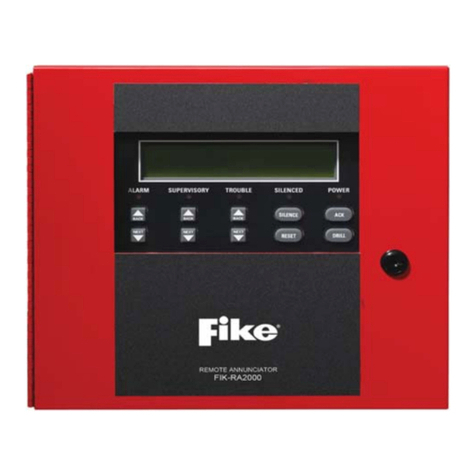
Fike
Fike FIK-RA2000 Technical manual
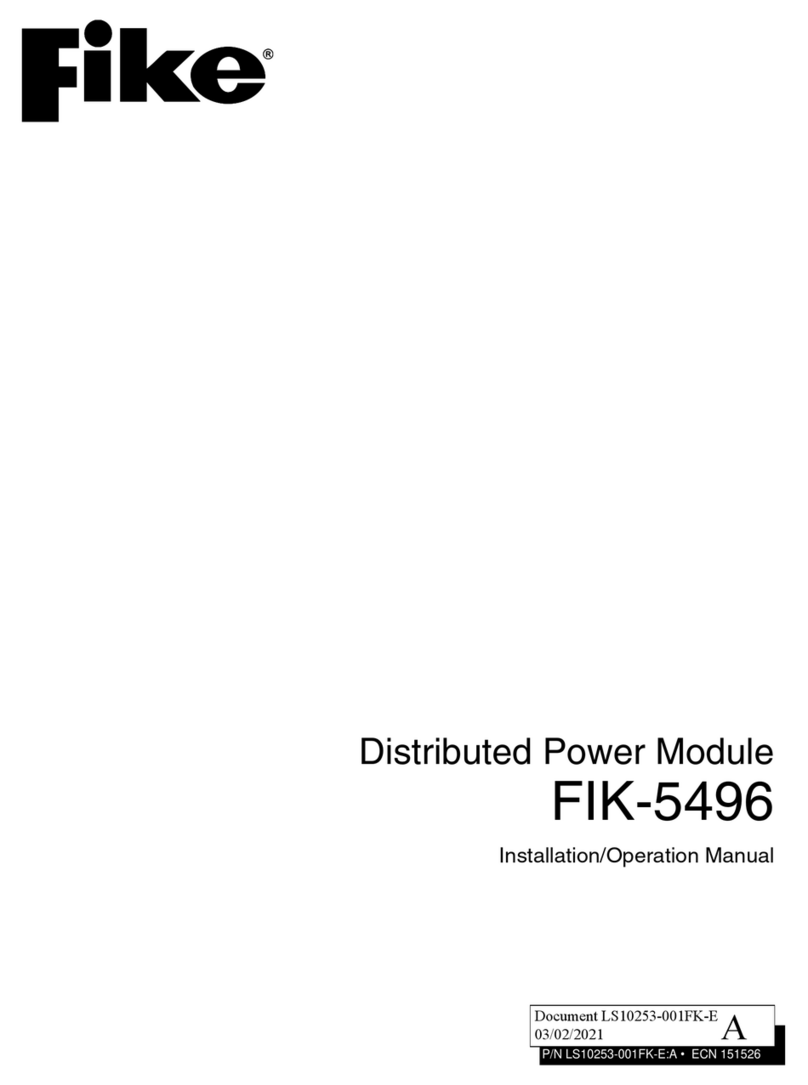
Fike
Fike FIK-5496 User manual
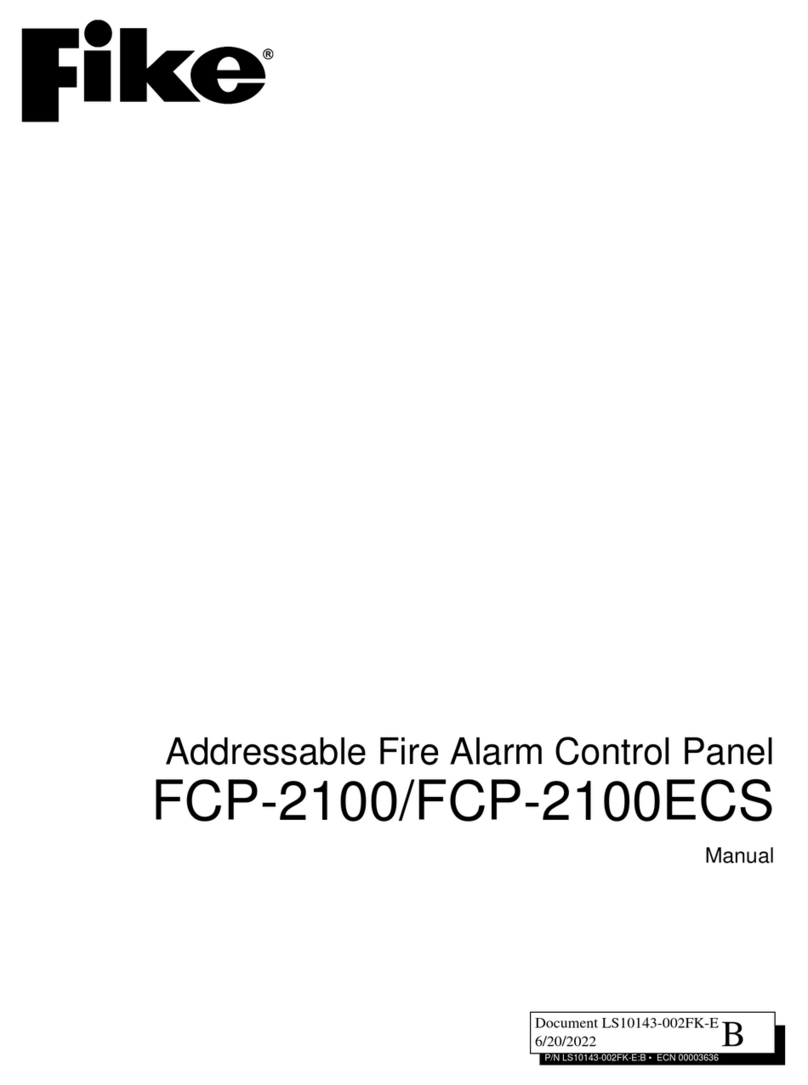
Fike
Fike FCP-2100ECS User manual

Fike
Fike SITA200plus User manual
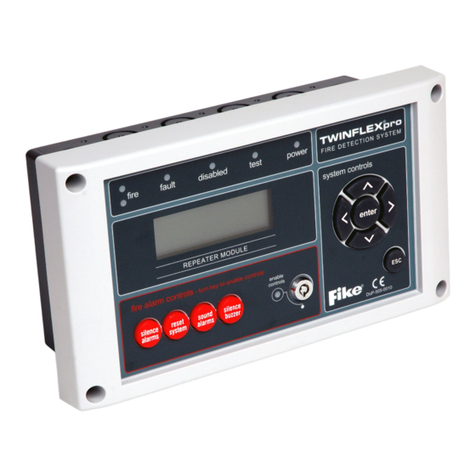
Fike
Fike TWINFLEXpro User manual
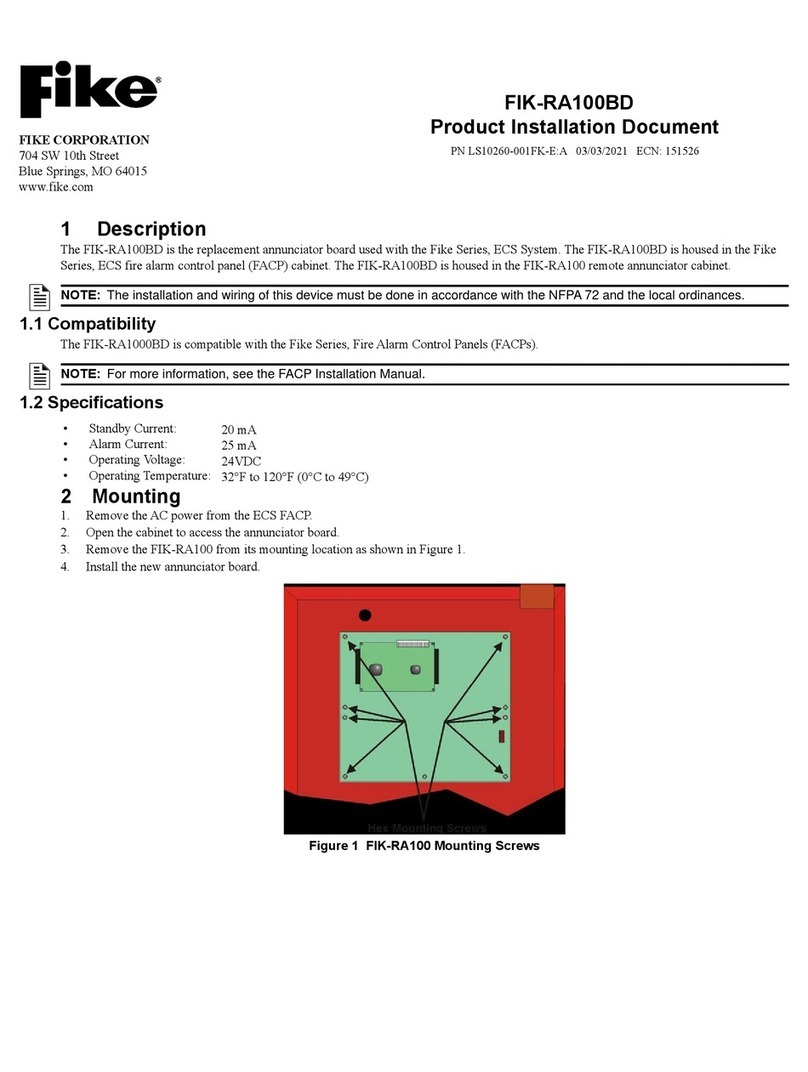
Fike
Fike FIK-RA100BD Technical manual
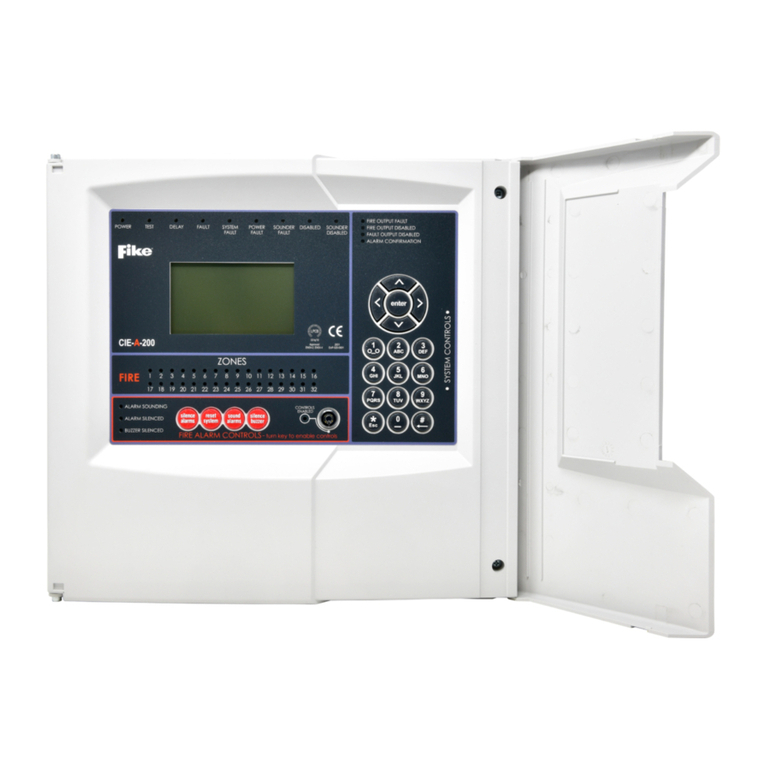
Fike
Fike CIE-A-200 User manual

Fike
Fike GB2426367 User manual

Fike
Fike FCP-75 User manual
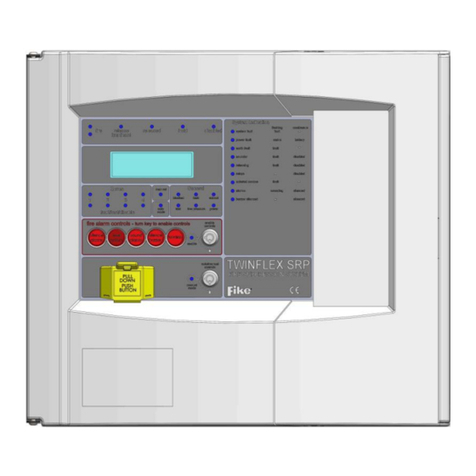
Fike
Fike TWINFLEX SRP 100-0001 User manual
Popular Control Panel manuals by other brands
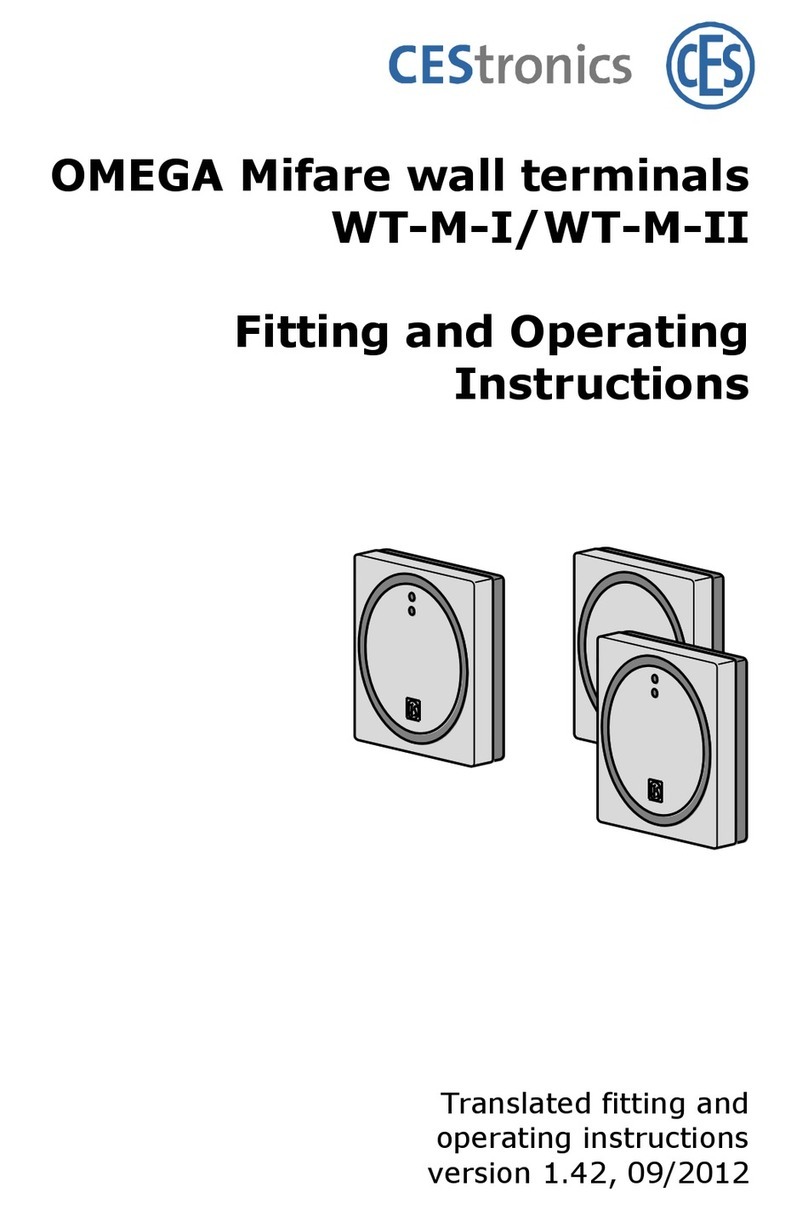
CEStronics
CEStronics WT-M-I Operating instruction
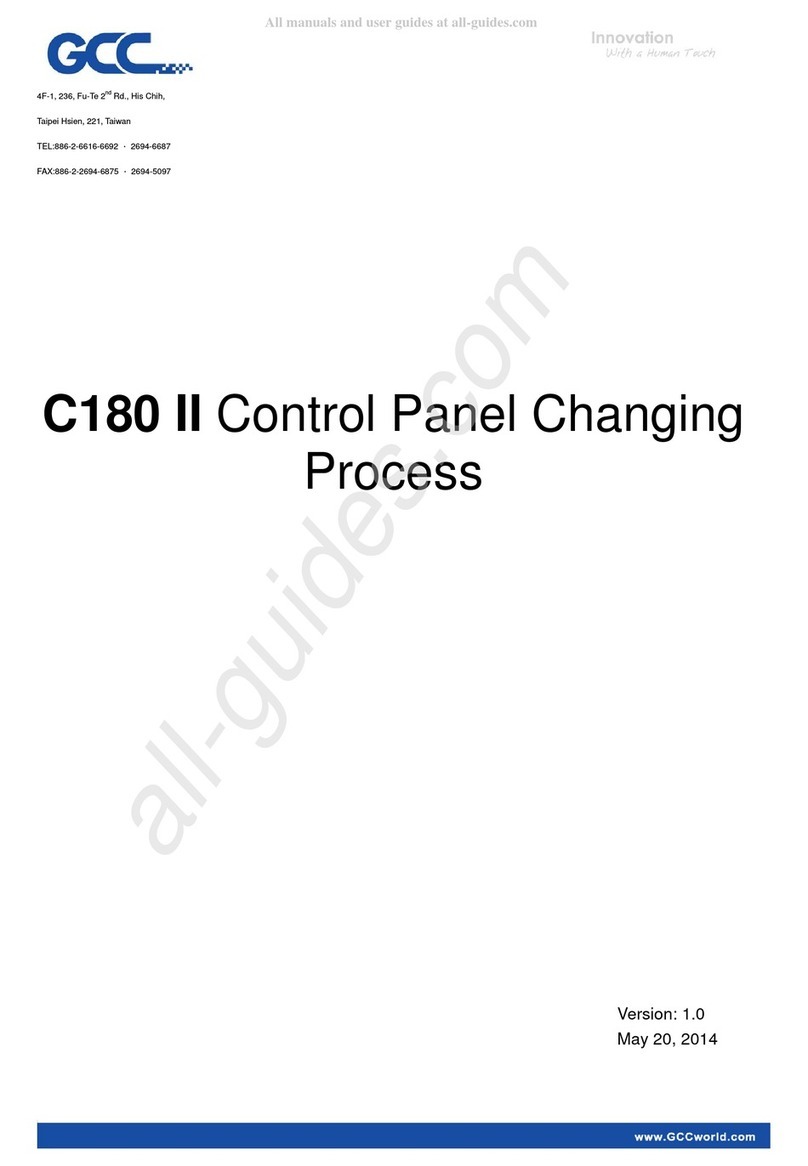
GCC Technologies
GCC Technologies LaserPro C180II quick start guide
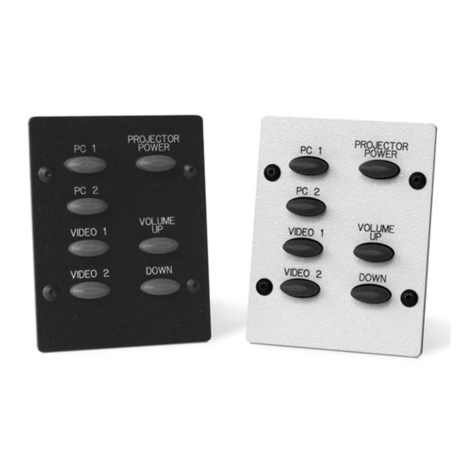
Extron electronics
Extron electronics CTP150CM user manual
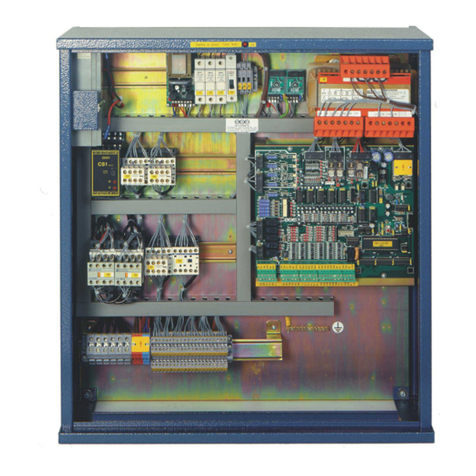
SEA
SEA Setronik1 Restyling Installation and use manual
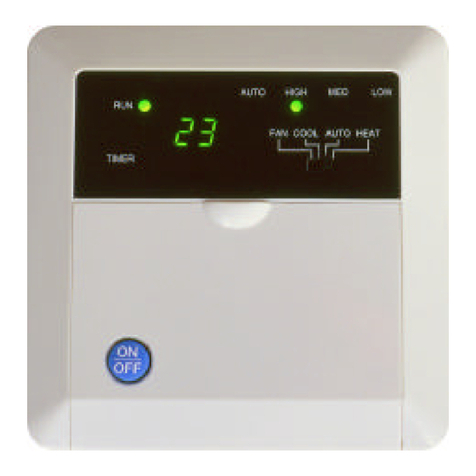
TemperZone
TemperZone HAN-L5 user manual
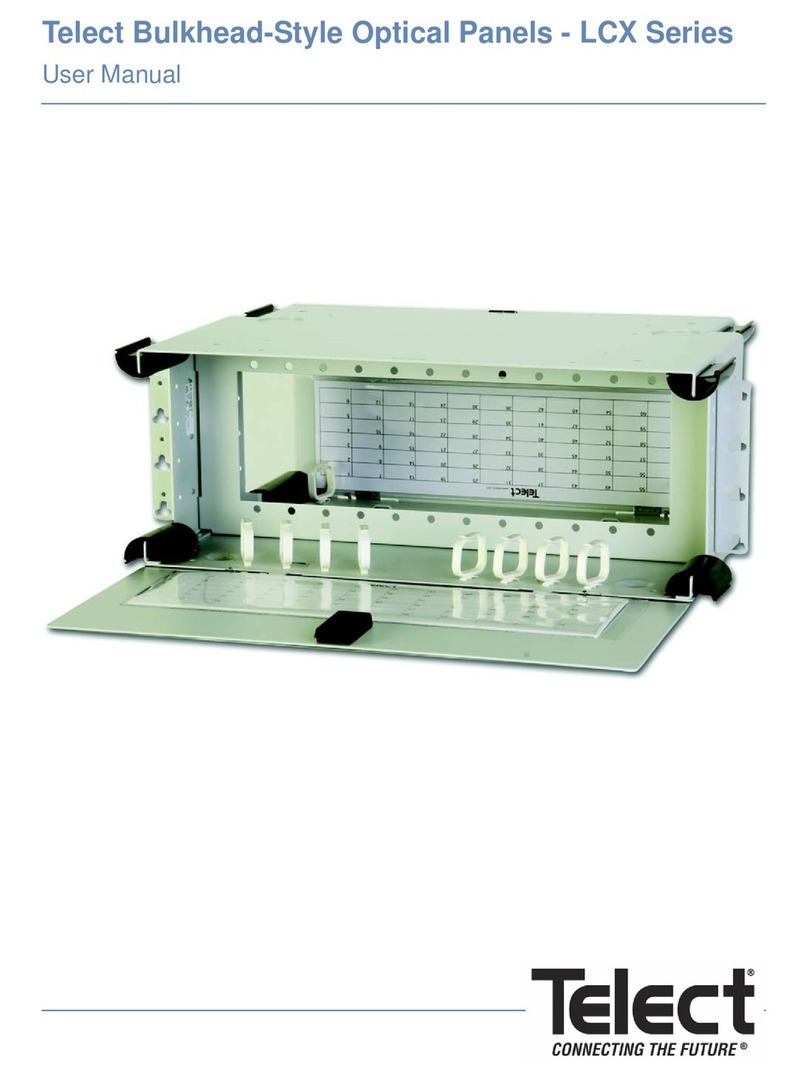
Telect
Telect LCX Series user manual

